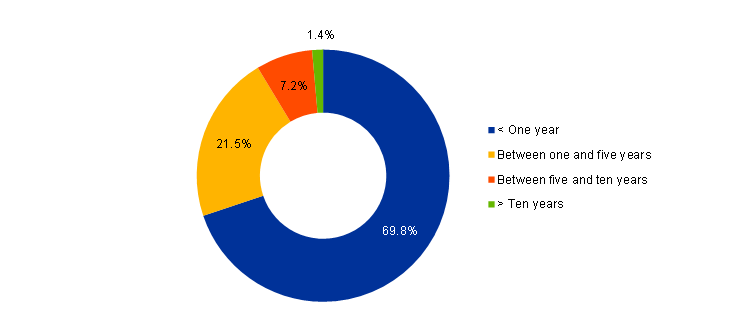Key figures
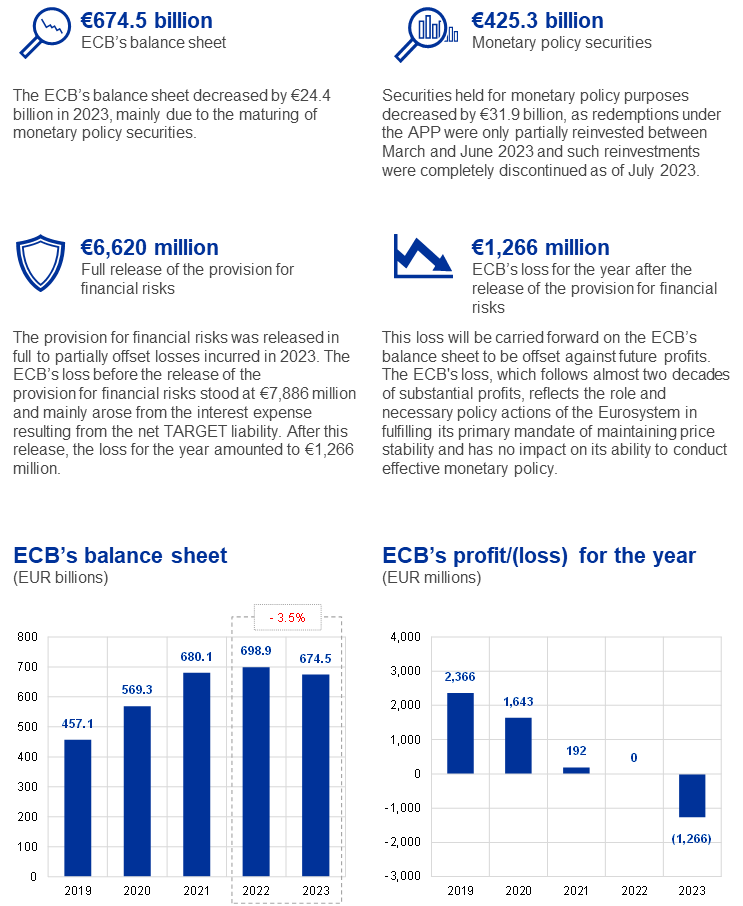
1 Management report
1.1 Purpose of the ECB’s management report
The management report[1] is an integral part of the ECB’s Annual Accounts and is designed to provide readers with contextual information related to the financial statements.[2] Given that the ECB’s activities and operations are undertaken in support of its policy objectives, the ECB’s financial position and result should be viewed in conjunction with its policy actions.
To this end, the management report presents the ECB’s main tasks and activities, as well as their impact on its financial statements. Furthermore, it analyses the main developments in the balance sheet and the profit and loss account during the year and includes information on the ECB’s net equity. Finally, it describes the risk environment in which the ECB operates, providing information on the specific risks to which the ECB is exposed, and the risk management policies used to mitigate risks.
1.2 Main tasks and activities
The ECB is part of the Eurosystem, which comprises, besides the ECB, the national central banks (NCBs) of the Member States of the European Union (EU) whose currency is the euro.[3] The Eurosystem has the primary objective of maintaining price stability. The ECB performs its tasks as described in the Treaty on the Functioning of the European Union[4] and in the Statute of the European System of Central Banks and of the European Central Bank (Statute of the ESCB)[5] (Figure 1). The ECB conducts its activities in order to fulfil its mandate and not with the intention of generating profit.
Figure 1
The ECB’s main tasks
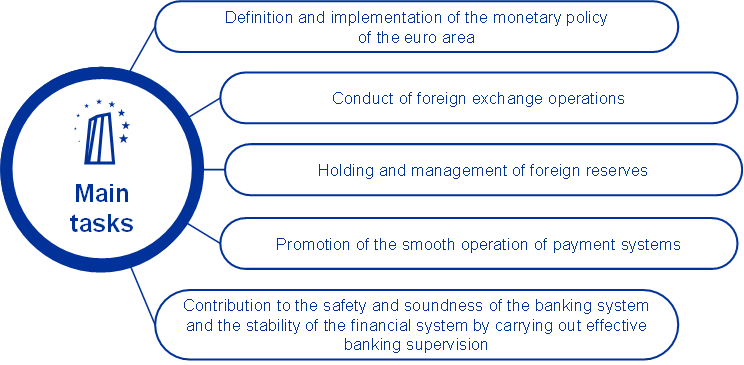
The Eurosystem’s monetary policy operations are recorded in the financial statements of the ECB and of the euro area NCBs, reflecting the principle of decentralised implementation of monetary policy in the Eurosystem. Table 1 below provides an overview of the main operations and functions of the ECB in pursuit of its mandate, and their impact on the ECB’s financial statements.
Table 1
The ECB’s key activities and their impact on its financial statements
Implementation of monetary policy
Liquidity provision in foreign currency | Liquidity provision to non-euro area central banks in euro |
|---|---|
The ECB acts as an intermediary between non-euro area central banks and the Eurosystem NCBs by means of swap transactions aimed at offering short-term foreign currency funding to Eurosystem counterparties.3 These operations are recorded in the balance sheet items “Liabilities to non-euro area residents denominated in euro” and “Other claims within the Eurosystem (net)” / “Other liabilities within the Eurosystem (net)”, as well as in off-balance-sheet accounts. Interest accruals are included in the ECB’s profit and loss account as “Other interest income” or “Other interest expense”. | The Eurosystem may provide euro liquidity to non-euro area central banks by means of swap and repo transactions in exchange for eligible collateral.4 For the ECB, the swap operations are recorded in the balance sheet items “Claims on non-euro area residents denominated in foreign currency” and “Liabilities to non-euro area residents denominated in euro” or “Other claims within the Eurosystem (net)” / “Other liabilities within the Eurosystem (net)”, as well as in off-balance-sheet accounts. Interest accruals are included in the ECB’s profit and loss account as “Other interest income” or “Other interest expense”. |
Conduct of foreign exchange operations and management of foreign reserves
Foreign exchange operations and management of foreign reserves |
|---|
The ECB’s foreign reserves are presented on the balance sheet, mainly under “Gold and gold receivables”, “Claims on non-euro area residents denominated in foreign currency” and “Claims on euro area residents denominated in foreign currency”, while any related liabilities would be presented under “Liabilities to euro area residents denominated in foreign currency” and “Liabilities to non-euro area residents denominated in foreign currency”. Foreign exchange transactions are reflected in off-balance-sheet accounts until the settlement date. Net interest income, including coupon accruals and amortised premiums and discounts, is included in the profit and loss account under the item “Interest income on foreign reserve assets”. Unrealised price and exchange rate losses exceeding previously recorded unrealised gains on the same items and realised gains and losses arising from the sale of foreign reserves are also included in the profit and loss account under the items “Write-downs on financial assets and positions” and “Realised gains/losses arising from financial operations” respectively. Unrealised gains are recorded on the balance sheet under the item “Revaluation accounts”. |
Promotion of the smooth operation of payment systems
Payment systems (TARGET) |
|---|
Intra-Eurosystem balances of euro area NCBs vis-à-vis the ECB arising from TARGET5 are presented together on the balance sheet of the ECB as a single net asset or liability position under “Other claims within the Eurosystem (net)” or “Other liabilities within the Eurosystem (net)”. TARGET balances of non-euro area NCBs vis-à-vis the ECB are recorded on the balance sheet under “Liabilities to non-euro area residents denominated in euro”. Balances of ancillary systems6 connected to TARGET through the TARGET-ECB component are recorded on the balance sheet under “Liabilities to other euro area residents denominated in euro” or “Liabilities to non-euro area residents denominated in euro”, depending on whether the managing entity is established in or outside the euro area. Interest accruals are included in the profit and loss account under “Other interest income” or “Other interest expense”. |
Contribution to the safety and soundness of the banking system and the stability of the financial system
Banking supervision – the Single Supervisory Mechanism |
|---|
The annual expenses of the ECB in relation to its supervisory tasks are recovered via annual supervisory fees levied on the supervised entities. The supervisory fees are included in the profit and loss account under the heading “Net income/expense from fees and commissions”. Furthermore, the ECB is entitled to impose administrative penalties on supervised entities for failure to comply with applicable EU banking law on prudential requirements (including ECB supervisory decisions). The related income is recorded in the profit and loss account under the heading “Net income/expense from fees and commissions”. |
Other
1) Further details on the Eurosystem’s monetary policy instruments and, more specifically, on the open market operations can be found on the ECB’s website.
2) Further details on securities lending can be found on the ECB’s website.
3) Further details on the currency swap lines can be found on the ECB’s website.
4) Further details on the Eurosystem’s euro liquidity operations against eligible collateral can be found on the ECB’s website.
5) Further details on TARGET can be found on the ECB’s website.
6) Ancillary systems are financial market infrastructures that have been granted access to the TARGET-ECB component by the Governing Council, provided they fulfil the requirements defined in Decision (EU) 2022/911 of the ECB of 19 April 2022 concerning the terms and conditions of TARGET-ECB and repealing Decision ECB/2007/7 (ECB/2022/22) (OJ L 163, 17.6.2022, p. 1), as amended. The unofficial consolidated text with the list of amendments can be found here. Further details on ancillary systems can be found on the ECB’s website.
1.3 Financial developments
1.3.1 Balance sheet
The ECB’s balance sheet expanded significantly in the period from 2019 to 2022, mainly owing to outright purchases of securities by the ECB in the context of the implementation of the monetary policy of the Eurosystem (Chart 1). In particular, the main drivers of the substantial expansion in 2020 and 2021 were net purchases of securities under the asset purchase programme (APP)[6] and the launch of the pandemic emergency purchase programme (PEPP)[7] in March 2020. Net purchases of securities under the PEPP and the APP were discontinued as of the end of March 2022 and 1 July 2022 respectively, leading to a more moderate increase in the ECB’s balance sheet in 2022.
Chart 1
Main components of the ECB’s balance sheet
(EUR billions)
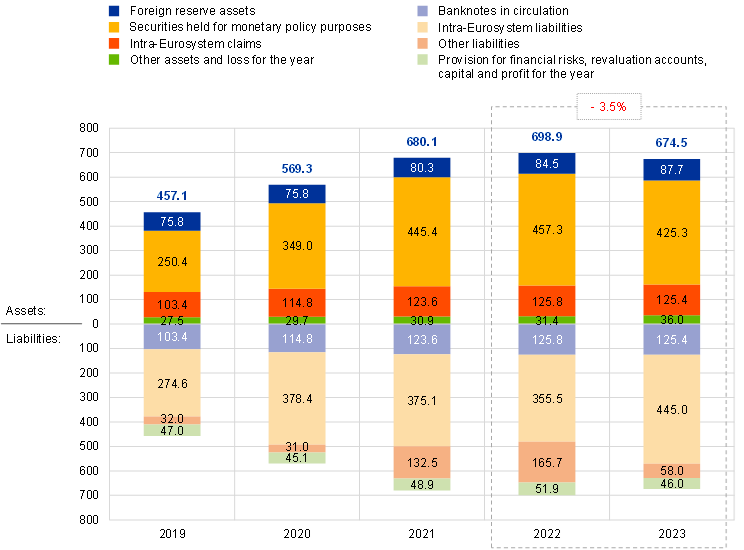
Source: ECB.

In 2023 the ECB’s balance sheet decreased by €24.4 billion to €674.5 billion, mainly owing to the gradual decline of APP holdings as a result of the only partial reinvestment of principal payments from maturing securities in this portfolio between March and June 2023 and the complete discontinuation of such reinvestments as of July 2023.

Euro-denominated securities held for monetary policy purposes made up 63% of the ECB’s total assets at the end of 2023. Under this balance sheet item, the ECB holds securities acquired in the context of the Securities Markets Programme (SMP), the CBPP3, the ABSPP, the PSPP and the PEPP. The securities purchased under these programmes are valued on an amortised cost basis subject to impairment.

Based on the relevant Governing Council decisions, the Eurosystem continued reinvesting, in full, the principal payments from maturing securities under the PEPP throughout the year, and under the APP until the end of February 2023. From the beginning of March until the end of June 2023, the Eurosystem reinvested only partially the principal payments from maturing securities under the APP and as of July 2023 discontinued these reinvestments. As a result of these decisions, the portfolio of securities held by the ECB for monetary policy purposes decreased by €31.9 billion to €425.3 billion (Chart 2) with the PSPP, ABSPP and CBPP3 holdings under the APP decreasing by €18.0 billion, €9.5 billion and €1.6 billion respectively, driven by redemptions. The PEPP portfolio decreased by €2.6 billion, mainly owing to the net impact of the amortisation of premiums and discounts[8] on securities held in the portfolio.
The Governing Council intends[9] to continue to reinvest, in full, the principal payments from maturing securities purchased under the PEPP during the first half of 2024. It then intends to reduce the PEPP portfolio at Eurosystem level by €7.5 billion per month on average over the second half of the year and to discontinue reinvestments at the end of 2024. The Governing Council will continue applying flexibility in reinvesting redemptions coming due in the PEPP portfolio, with a view to countering risks to the monetary policy transmission mechanism related to the pandemic.
Chart 2
Securities held for monetary policy purposes
(EUR billions)
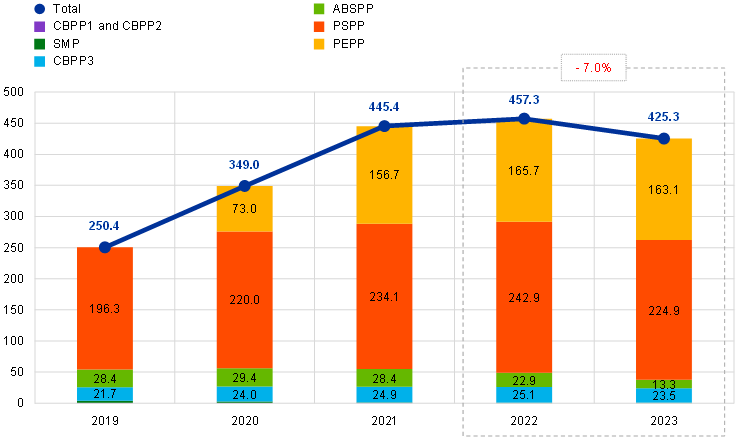
Source: ECB.
For the active programmes of securities held for monetary policy purposes, namely the APP and the PEPP, securities held by the ECB at the end of 2023 had a diversified maturity profile[10] (Chart 3).
Chart 3
Maturity profile of the APP and the PEPP
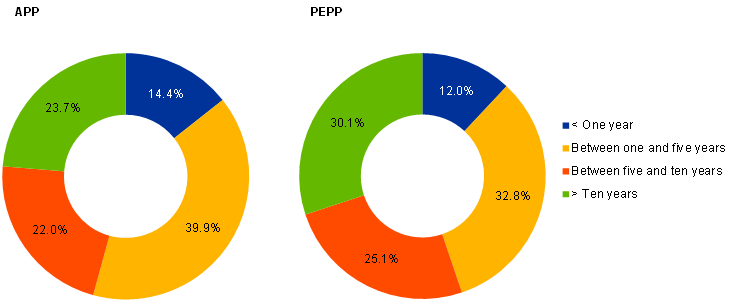
Source: ECB.
Note: For asset-backed securities, the maturity profile is based on the weighted average life of the securities rather than the legal maturity date.
In 2023 the total euro equivalent value of the ECB’s foreign reserve assets, which consist of gold, special drawing rights, US dollars, Japanese yen and Chinese renminbi, increased by €3.3 billion to €87.7 billion.
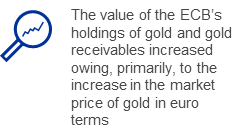
The euro equivalent value of the ECB’s holdings of gold and gold receivables increased by €2.7 billion to €30.4 billion in 2023 (Chart 4) owing, primarily, to an increase in the market price of gold in euro terms. This increase also led to an equivalent rise in the ECB’s gold revaluation accounts (see Section 1.3.2 “Net equity”). In addition, upon the adoption of the single currency by Croatia with effect from 1 January 2023, Hrvatska narodna banka transferred to the ECB gold with a value of €96 million.
Chart 4
Gold holdings and gold prices
(left-hand scale: EUR billions; right-hand scale: euro per fine ounce of gold)
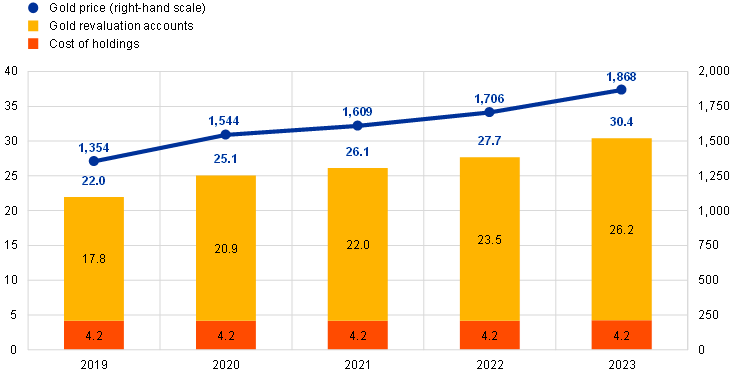
Source: ECB.
Note: “Gold revaluation accounts” does not include the contributions of the central banks of the Members States that joined the euro area after 1 January 1999 to the accumulated gold revaluation accounts of the ECB as at the day prior to their entry into the Eurosystem.
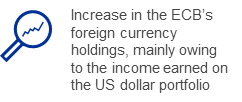
The ECB’s foreign currency holdings[11] of US dollars, Japanese yen and Chinese renminbi increased in euro terms by €0.2 billion to €55.2 billion (Chart 5), mainly owing to the income earned during the year, primarily on the US dollar portfolio. In addition, upon the adoption of the single currency by Croatia with effect from 1 January 2023, Hrvatska narodna banka transferred to the ECB foreign reserve assets denominated in US dollars with a value of €544 million. The increase in the total value of foreign currency holdings was partially offset, mainly by the depreciation of the US dollar and the Japanese yen against the euro.
Chart 5
Foreign currency holdings
(EUR billions)

Source: ECB.
The US dollar is the main component of the ECB’s foreign currency holdings, accounting for 81% of the total at the end of 2023.
The ECB manages the investment of its foreign currency holdings using a three-step approach. First, a strategic benchmark portfolio is designed by the ECB’s risk managers and approved by the Governing Council. Second, the ECB’s portfolio managers design the tactical benchmark portfolio, which is approved by the Executive Board. Third, investment operations are conducted in a decentralised manner by the NCBs on a day-to-day basis.
The ECB’s foreign currency holdings are mainly invested in securities and money market deposits or are held in current accounts (Chart 6). Securities in this portfolio are valued at year-end market prices.
Chart 6
Composition of foreign currency investments
(EUR billions)
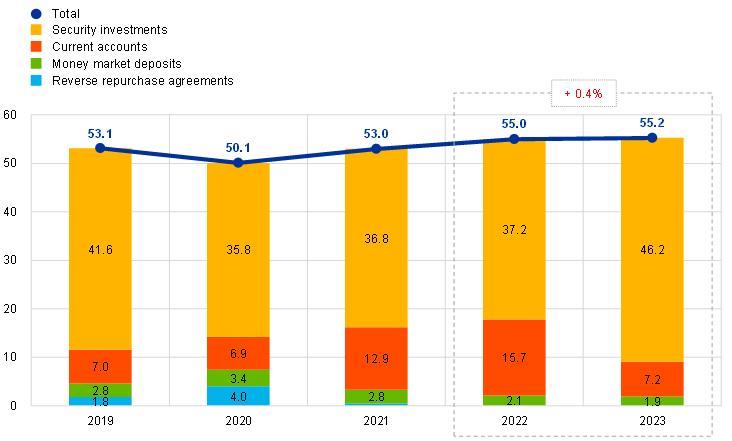
Source: ECB.
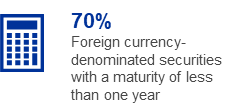
The purpose of the ECB’s foreign currency holdings is to finance potential interventions in the foreign exchange market. For this reason, the ECB’s foreign currency holdings are managed in accordance with three objectives (in order of priority): liquidity, safety and return. Therefore, this portfolio mainly comprises securities with short maturities (Chart 7).
The value of the own funds portfolio increased by €1.0 billion to €22.1 billion (Chart 8), primarily owing to (i) the reinvestment of interest income generated on this portfolio and (ii) the increase in the market value of euro-denominated securities held in this portfolio as a result of the decline in euro area bond yields at the year-end (Chart 17).
The portfolio mainly consists of euro-denominated securities which are valued at year-end market prices. In 2023 government debt securities accounted for 77% of the total portfolio.

The share of green investments in the own funds portfolio continued to increase, rising from 13% at the end of 2022 to 20% at the end of 2023. The ECB plans to further increase this share over the coming years.[12] Since 2021 purchases of green bonds in secondary markets are complemented by investments in the euro-denominated green bond investment fund for central banks launched by the Bank for International Settlements in January 2021.
Chart 8
The ECB’s own funds portfolio
(EUR billions)
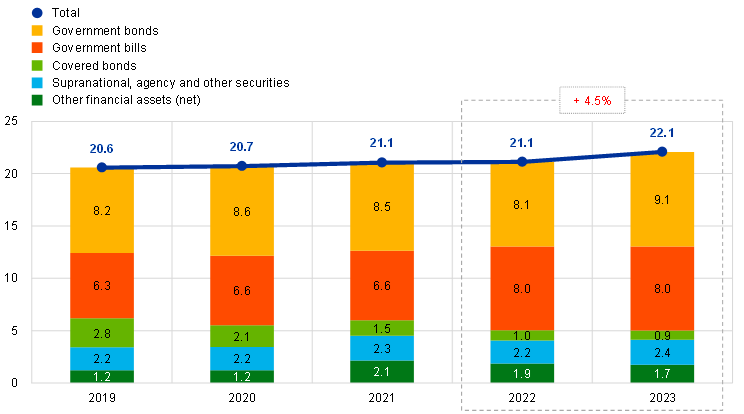
Source: ECB.
The ECB’s own funds portfolio predominantly consists of investments of its paid-up capital and amounts set aside in the general reserve fund and in the provision for financial risks. The purpose of this portfolio is to provide income to help fund those ECB operating expenses that are not related to the delivery of its supervisory tasks.[13] It is invested in euro-denominated assets, subject to the limits imposed by its risk control framework. This results in a more diversified maturity structure (Chart 9) than in the foreign reserves portfolio.
Chart 9
Maturity profile of the ECB’s own funds securities
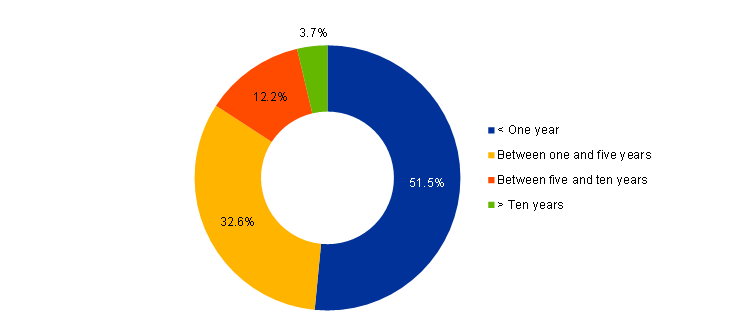
Source: ECB.
At the end of 2023 the total value of euro banknotes in circulation was €1,567.7 billion, virtually the same as at the end of 2022. The ECB has been allocated an 8% share of the total value of euro banknotes in circulation, which amounted to €125.4 billion at the end of the year. Since the ECB does not issue banknotes itself, it holds intra-Eurosystem claims vis-à-vis the euro area NCBs for a value equivalent to the value of the banknotes in circulation allocated to it.
The ECB’s intra-Eurosystem liabilities, which mainly comprise the net TARGET balance of euro area NCBs vis-à-vis the ECB and the ECB’s liabilities with regard to the foreign reserve assets transferred to it by the euro area NCBs when they joined the Eurosystem, increased by €89.6 billion to €445.0 billion in 2023.
The development of the intra-Eurosystem liabilities is mainly driven by the evolution of the net TARGET liability. The main factors contributing to the changes in the net TARGET liability during the period 2019-2023 were purchases and redemptions of monetary policy securities, which are settled via TARGET accounts, and changes in liabilities to euro area and non-euro area residents denominated in euro (Chart 10). In 2023 the cash inflows from redemptions of monetary policy securities were lower than the cash outflows related to the decrease in liabilities to euro area and non-euro area residents denominated in euro, leading to an overall increase in the net TARGET liability.
Chart 10
Net intra-Eurosystem TARGET balance, liabilities to euro area and non-euro area residents denominated in euro and securities held for monetary policy purposes
(EUR billions)
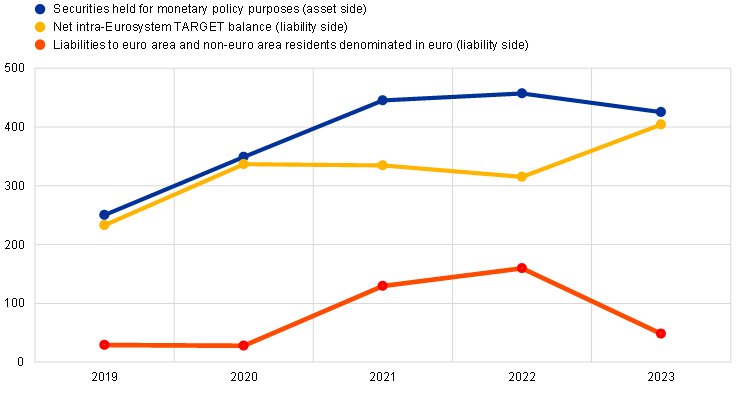
Source: ECB.
Note: For the purpose of this chart, “Liabilities to euro area and non-euro area residents denominated in euro” consists of “Other liabilities to euro area credit institutions denominated in euro”, “Liabilities to other euro area residents denominated in euro” and “Liabilities to non-euro area residents denominated in euro”.
In 2023 the ECB’s other liabilities fell by €107.7 billion to €58.0 billion owing to the decrease in liabilities to euro area and non-euro area residents denominated in euro. Specifically, there were reductions in (i) deposits accepted by the ECB in its role as fiscal agent[14], (ii) balances of non-euro area ancillary systems connected to TARGET through the TARGET-ECB component and (iii) cash received as collateral against the lending of PSPP and public sector PEPP securities.
1.3.2 Net equity

The ECB’s net equity consists of its capital, any amounts held in the provision for financial risks and the general reserve fund, the revaluation accounts[15], any accumulated losses from previous years and any profit/loss for the year.[16]
At the end of 2023 the ECB’s net equity totalled €44.5 billion (Chart 11), which was €7.0 billion lower than at the end of 2022 owing to the losses incurred during 2023. The provision for financial risks was fully used to cover part of these losses, reducing the loss for the year to €1.3 billion. The decrease in the ECB’s net equity arising from the 2023 losses was partially offset by (i) the increase in the revaluation accounts, mainly as a result of the rise in the market price of gold in euro terms in 2023, and (ii) the contributions from Hrvatska narodna banka to the paid-up capital, the revaluation accounts and the provision for financial risks following the adoption of the single currency by Croatia with effect from 1 January 2023.
Chart 11
The ECB’s net equity
(EUR billions)
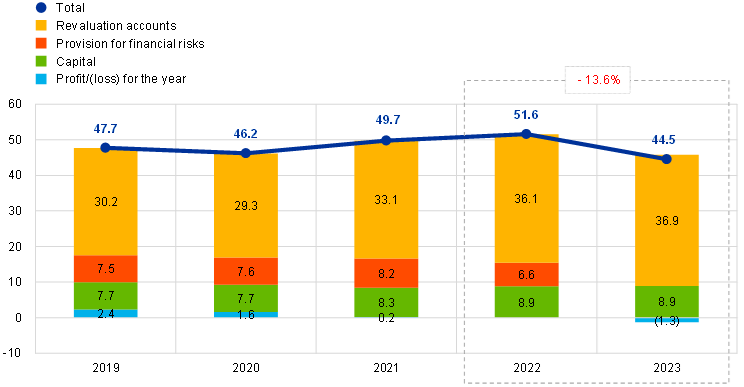
Source: ECB.
Note: “Revaluation accounts” includes total revaluation gains on gold, foreign currency and securities holdings, but excludes the revaluation account for post-employment benefits.
Changes in the ECB’s net equity during the year are presented in Table 2.
Table 2
Changes in the ECB’s net equity
(EUR millions)
Capital | Provision for financial risks | Revaluation accounts | Profit/(loss) for the year | Total net equity | |
|---|---|---|---|---|---|
Balance as at 31 December 2022 | 8,880 | 6,566 | 36,118 | - | 51,564 |
Payment of the remainder of the capital subscription by Hrvatska narodna banka | 69 | 69 | |||
Contribution to the provision for financial risks by Hrvatska narodna banka | 53 | 53 | |||
Revaluation accounts | 743 | ||||
Gold | 2,634 | ||||
Foreign currency | (2,562) | ||||
Securities and other instruments | 378 | ||||
Contribution to the revaluation accounts by Hrvatska narodna banka1 | 293 | ||||
Release from provision for financial risks | (6,620) | (6,620) | |||
Loss for the year | (1,266) | (1,266) | |||
Balance as at 31 December 2023 | 8,948 | - | 36,861 | (1,266) | 44,543 |
1) Upon the adoption of the single currency by Croatia, Hrvatska narodna banka contributed to the balances of all the revaluation accounts of the ECB as at 31 December 2022. The figure in this table excludes the contribution to the revaluation account for post-employment benefits, in line with the definition of “Revaluation accounts” in this section.

Unrealised gains on gold and foreign currencies and unrealised gains on securities that are subject to price revaluation are not recognised as income in the profit and loss account but are recorded directly in revaluation accounts shown on the liability side of the ECB’s balance sheet. The balances in these accounts can be used to absorb the impact of any future unfavourable movement in the respective prices and/or exchange rates and thus strengthen the ECB’s resilience against the underlying risks. In 2023 the revaluation accounts for gold, foreign currencies and securities increased by €0.7 billion to €36.9 billion, mainly owing to higher revaluation balances for gold as a result of the rise in the market price of gold in euro terms. The revaluation balances for foreign currencies decreased, mainly owing to the depreciation of the US dollar and the Japanese yen against the euro (Chart 12).
Chart 12
The main foreign exchange rates and gold price over the period 2019-23
(percentage changes vis-à-vis 2019; year-end data)

Source: ECB.

In view of its exposure to financial risks (see Section 1.4.1 “Financial risks”), the ECB may set aside a provision for financial risks to be used to the extent deemed necessary by the Governing Council to offset losses that arise as a result of this exposure. The size of this provision is reviewed annually, taking a range of factors into account, including the level of holdings of risk-bearing assets, the projected results for the coming year and a risk assessment. The provision for financial risks, together with any amount held in the ECB’s general reserve fund, may not exceed the value of the capital paid up by the euro area NCBs. At the end of 2022 this provision amounted to €6,566 million. Upon the adoption of the single currency by Croatia, Hrvatska narodna banka contributed €53 million to the provision for financial risks with effect from 1 January 2023, increasing its size to €6,620 million. At the end of 2023, following the annual review, the Governing Council decided to release this provision in full to partially offset losses incurred in 2023. The Governing Council may decide to replenish the provision for financial risks, in the context of its annual review, once the ECB returns to making a profit.
The ECB’s loss for the year, after the release of the provision for financial risks, was €1.3 billion (see Section 1.3.3 “Profit and loss account”). The Governing Council decided to carry forward this loss on the ECB’s balance sheet to be offset against future profits.
1.3.3 Profit and loss account
The ECB’s result has gradually fallen since 2019 (Chart 13). In 2020 and 2021 this decrease was mainly driven by lower income generated on foreign reserve assets and on securities held for monetary policy purposes. In 2022 and 2023 the reduction in the ECB’s result was primarily due to the materialisation of interest rate risk, as the rise in interest rates in the euro area led to an immediate increase in the interest expense paid by the ECB on its net TARGET liability, while the income earned on the ECB’s assets did not increase to the same extent or at the same pace (see Section 1.4.1 “Financial risks”).

The ECB’s loss for 2023, which followed a long period of substantial profits, reflects the role and necessary policy actions of the Eurosystem in fulfilling its primary mandate of maintaining price stability and has no impact on its ability to conduct effective monetary policy. In the previous years the ECB’s balance sheet expanded significantly, mainly driven by the purchase of securities under the asset purchase programmes. On the asset side, most monetary policy securities currently held were purchased during a period of low interest rates and have long maturities and fixed coupons. These will continue to generate relatively low interest income, not immediately affected by changes in key ECB interest rates. At the same time, the cash settlement of these purchases via TARGET led to a rise in the ECB’s net TARGET liability, which is remunerated at the rate on the main refinancing operations (MRO rate). In order to combat inflation in the euro area, this rate began to be raised in 2022, resulting in an immediate increase in the ECB’s interest expense.

The ECB is likely to incur further losses over the next few years as a result of the materialisation of interest rate risk, before returning to making sustained profits. The occurrence and magnitude of these losses are uncertain and will largely depend on the future evolution of key ECB interest rates and the size and composition of the ECB’s balance sheet. However, the ECB’s capital and its substantial revaluation accounts, which together amounted to €45.8 billion at the end of 2023 (see Section 1.3.2 “Net equity”), underline its financial strength, and, in any case, the ECB can operate effectively and fulfil its primary mandate of maintaining price stability regardless of any losses.
Chart 13
Main components of the ECB’s profit and loss account
(EUR millions)
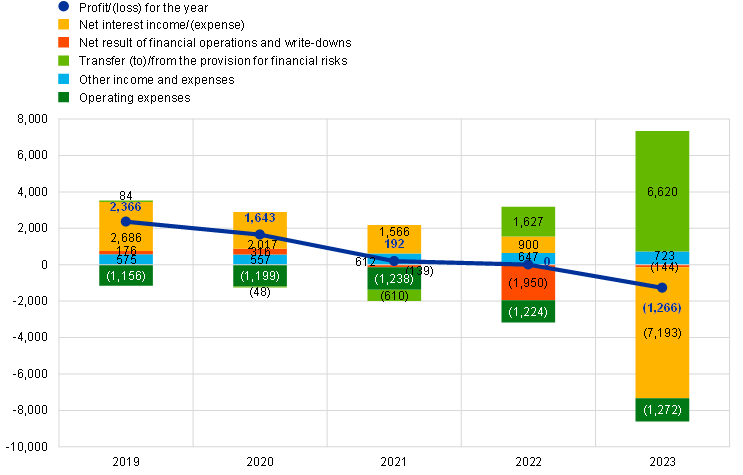
Source: ECB.
Note: “Other income and expenses” consists of “Net income/expense from fees and commissions”, “Income from equity shares and participating interests”, “Other income” and “Other expenses”.

In 2023 the ECB used the full amount of €6,620 million set aside in the provision for financial risks to partially offset losses incurred during the year. After the release of this provision, the ECB’s loss stood at €1,266 million (2022: zero). The main driver of this loss was the significant net interest expense (Chart 14).
Chart 14
Drivers of the ECB’s result for 2022 and 2023
(EUR millions)
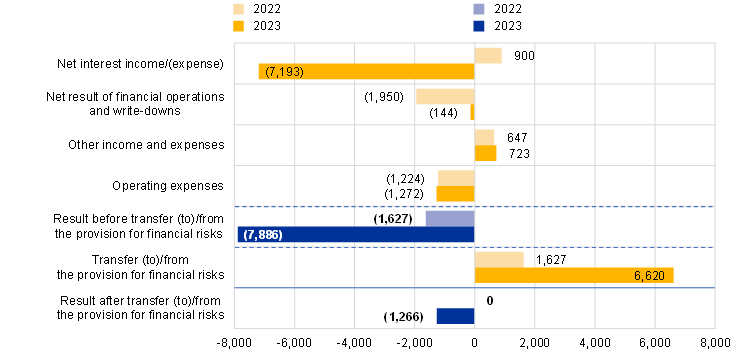
Source: ECB.

The ECB’s net interest expense amounted to €7,193 million in 2023, compared to net interest income of €900 million in 2022 (Chart 15). This was mainly due to the interest expense arising from the ECB’s net TARGET liability. The net other interest expense and the interest expense related to the remuneration of euro area NCBs’ claims in respect of foreign reserves transferred to the ECB also contributed to this decrease. These expenses were partially offset by higher interest income arising from (i) the ECB’s claims related to the allocation of euro banknotes within the Eurosystem, (ii) securities held for monetary policy purposes and (iii) foreign reserve assets.
Chart 15
Net interest income/(expense)
(EUR millions)
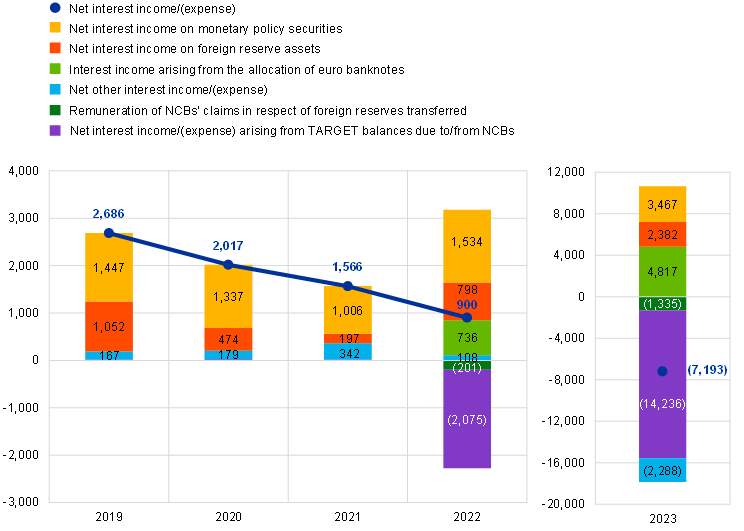
Source: ECB.

Net interest income generated on securities held for monetary policy purposes increased by €1,933 million to €3,467 million in 2023 (Chart 16) owing to higher net interest income from securities held under the APP (under the CBPP3, ABSPP and PSPP) and the PEPP. Net interest income from the APP holdings rose by €1,247 million to €2,818 million in 2023, while the PEPP portfolio generated net interest income of €600 million in 2023, compared to a net interest expense of €103 million the year before. These developments were mainly driven by the significant increase in euro area interest rates and bond yields which began in 2022 (Chart 17) and which (i) allowed reinvestments under the APP and the PEPP at higher yields than the historical yields of the respective portfolios and (ii) had a positive impact on the coupon on securities with variable interest rates (mainly held under the ABSPP). Lower premium amortisation, particularly on public sector securities acquired in the past, also contributed to the increase. Net interest income on the SMP decreased by €16 million to €49 million owing to the decline in the size of the portfolio as a result of maturing securities.
Chart 16
Net interest income/(expense) on securities held for monetary policy purposes
(EUR millions)
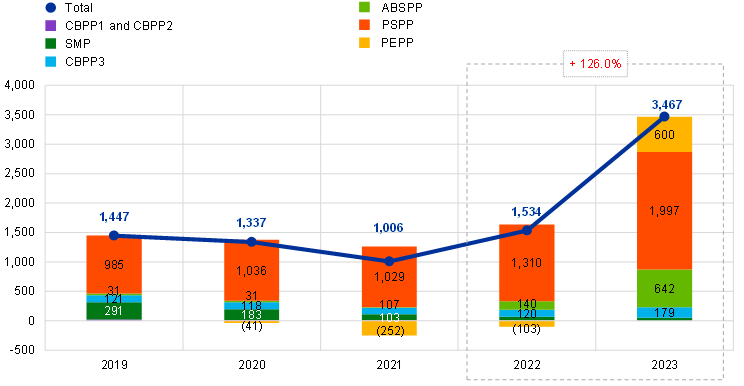
Source: ECB.
Chart 17
Seven-year sovereign bond yields in the euro area
(percentages per annum; month-end data)
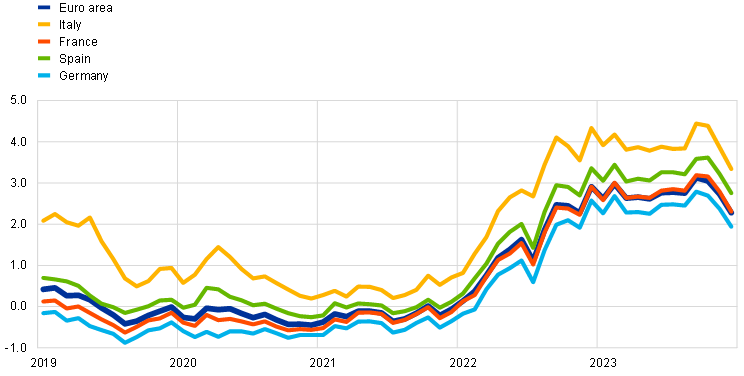
Source: ECB.

Net interest income on foreign reserve assets increased by €1,583 million to €2,382 million, predominantly as a result of higher interest income from securities denominated in US dollars. The average interest rate earned on the ECB’s US dollar portfolio increased in 2023 compared to the previous year owing to (i) sales and redemptions of lower-yield bonds purchased in the past and (ii) purchases of securities with higher yields following the increase in US dollar bond yields since the end of 2021 (Chart 18).
Chart 18
Two-year sovereign bond yields in the United States, Japan and China
(percentages per annum; month-end data)
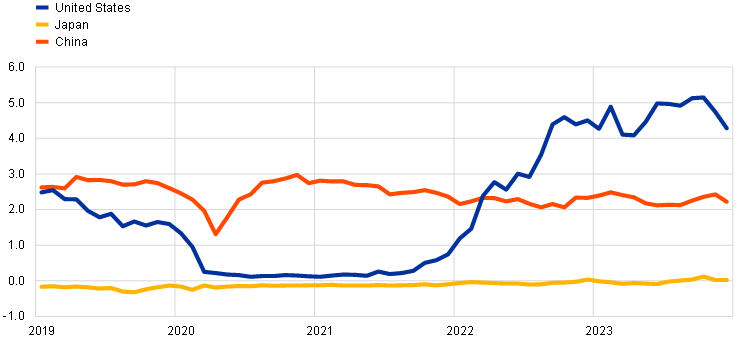
Source: LSEG.

Interest income arising from the allocation of euro banknotes to the ECB and interest expense stemming from the remuneration of NCBs’ claims in respect of foreign reserves transferred increased by €4,081 million to €4,817 million and by €1,133 million to €1,335 million respectively in 2023. The changes were the result of increases in the MRO rate, which is the rate used for the calculation of interest on these balances. The MRO rate reached 4.5% at the end of 2023, while the annual average rate increased from 0.6% in 2022 to 3.8% in 2023.
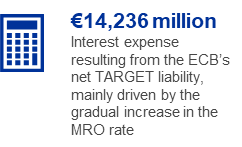
The net interest expense arising from TARGET balances due to/from NCBs increased by €12,161 million to €14,236 million in 2023. The increase was mainly driven by the higher average MRO rate in 2023, which is used for the remuneration of the ECB’s intra-Eurosystem TARGET balances.
The net other interest expense of €2,288 million in 2023 compares with net other interest income of €108 million in the previous year. This change was mainly due to the remuneration of deposits accepted by the ECB in its role as fiscal agent and the remuneration of balances of euro area ancillary systems. In the second half of 2022, once the applicable remuneration rates turned positive, the ECB started to pay interest on these items. In 2023 the remuneration rates and average balance of these items rose further, leading to an increase in the interest expense. This interest expense was partially offset by the higher interest income earned on the own funds portfolio as a result of rising yields in the euro area (Chart 17).

Net realised losses arising from financial operations decreased by €4 million to €106 million in 2023 (Chart 19). These losses mainly resulted from (i) outstanding premiums on securities held in the ABSPP that were repaid before maturity and (ii) net realised price losses on sales of US dollar-denominated securities in the second half of 2023 (Chart 20) whose market value was negatively affected by the increase in US dollar bond yields during this period (Chart 18).
Chart 19
Realised gains/losses arising from financial operations
(EUR millions)
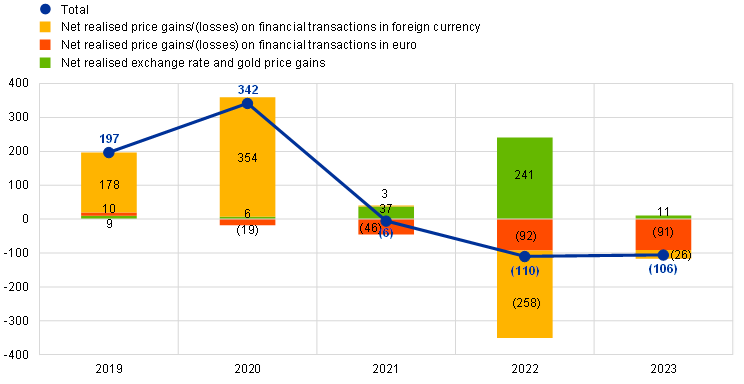
Source: ECB.
Chart 20
Quarterly realised gains/losses arising from financial operations in 2022 and 2023
(EUR millions)
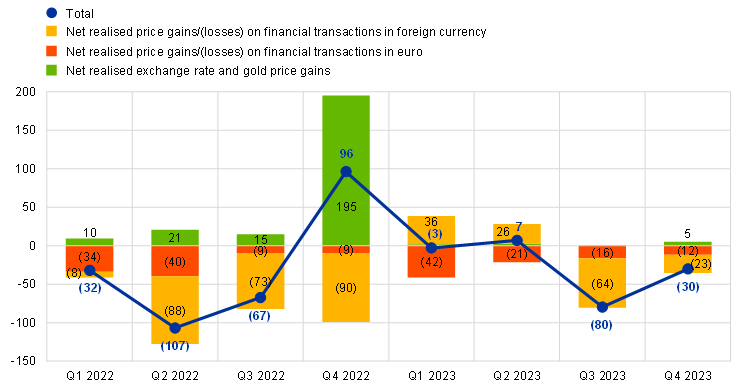
Source: ECB.

Unrealised revaluation losses are expensed in the form of write-downs at the year-end in the ECB’s profit and loss account. In 2023 these write-downs amounted to €38 million, mainly stemming from unrealised price losses on a number of securities held in the US dollar and own funds portfolios. In 2022 these losses were substantially higher at €1,840 million (Chart 21), as the corresponding yields had increased significantly, resulting in a large reduction in the market value of the majority of securities held in the own funds and US dollar portfolios at the end of that year.
Chart 21
Write-downs on financial assets and positions
(EUR millions)
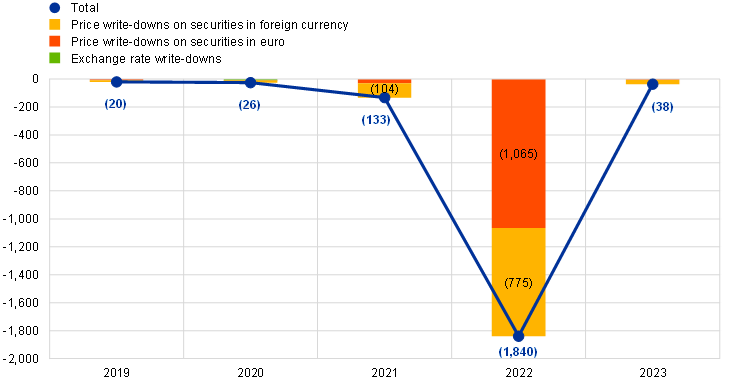
Source: ECB.
The total operating expenses of the ECB, including depreciation and banknote production services, increased by €48 million to €1,272 million (Chart 22). The increase compared to 2022 was mainly due to higher staff costs resulting from the higher average number of staff in 2023, predominantly in banking supervision, as well as salary adjustments. This increase was partially offset by lower costs in relation to post-employment benefits, mainly as a result of a lower current service cost following the annual actuarial valuation. Administrative expenses increased, mainly owing to higher expenses for external consultancy support and the return to full levels of activity following the pandemic, in particular in banking supervision, while also reflecting the impact of inflation.

Banking supervision-related expenses are fully covered by fees levied on the supervised entities. Based on the actual expenses incurred by the ECB in the performance of its banking supervision tasks, supervisory fee income for 2023 stood at €654 million.[17]
Chart 22
Operating expenses and supervisory fee income
(EUR millions)
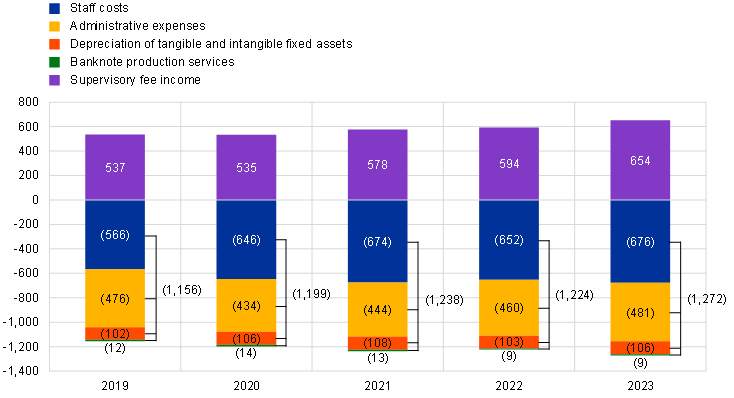
Source: ECB.
1.4 Risk management
Risk management is a critical part of the ECB’s activities and is conducted through a continuous process of (i) risk identification and assessment, (ii) review of the risk strategy and policies, (iii) implementation of risk-mitigating actions and (iv) risk monitoring and reporting, all of which are supported by effective methodologies, processes and systems.
Figure 2
Risk management cycle
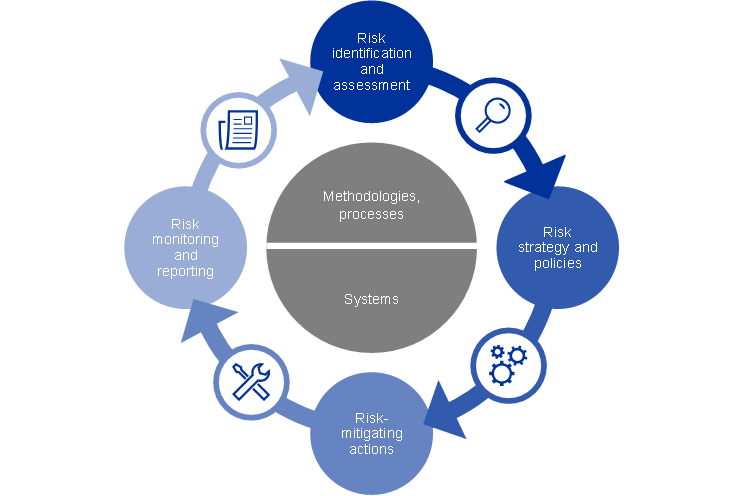
The following sections focus on the risks, their sources and the applicable risk control frameworks.
1.4.1 Financial risks
The Executive Board proposes policies and procedures that ensure an appropriate level of protection against the financial risks to which the ECB is exposed. The Risk Management Committee (RMC), which comprises experts from Eurosystem central banks, contributes to the monitoring, measuring and reporting of financial risks related to the balance sheet of the Eurosystem and defines and reviews the associated methodologies and frameworks. In this way, the RMC helps the decision-making bodies to ensure an appropriate level of protection for the Eurosystem.
Financial risks arise from the ECB’s operations and associated exposures. The risk control frameworks and limits that the ECB uses to manage its risk profile differ across types of operation, reflecting the policy or investment objectives of the different portfolios and the risk characteristics of the underlying assets.
To monitor and assess the risks, the ECB relies on a number of risk estimation techniques developed by its experts. These techniques are based on a joint market and credit risk simulation framework. The core modelling concepts, techniques and assumptions underlying the risk measures draw on industry standards and available market data. The risks are typically quantified as the expected shortfall (ES)[18], estimated at the 99% confidence level over a one-year horizon. Two approaches are used to calculate risks: (i) the accounting approach, under which the ECB’s revaluation accounts are considered as a buffer in the calculation of risk estimates in line with applicable accounting rules; and (ii) the financial approach, under which the revaluation accounts are not considered as a buffer in the risk calculation. The ECB also calculates other risk measures at different confidence levels, performs sensitivity and stress scenario analyses and assesses longer-term projections of exposures and income to maintain a comprehensive picture of the risks.[19]

The total risks of the ECB decreased during the year. At the end of 2023 the total financial risks of the ECB’s balance sheet, as measured by the ES at the 99% confidence level over a one-year horizon under the accounting approach, stood at €16.7 billion, which was €1.6 billion lower than the risks estimated as at the end of 2022 (Chart 23). The decrease in risk reflects the reduction in the ECB’s holdings under the APP, initially through the only partial reinvestment of principal payments from maturing securities between March and June 2023, followed by the complete discontinuation of reinvestments as of July 2023.
Chart 23
Total financial risks (ES 99%, accounting approach)
(EUR billions)
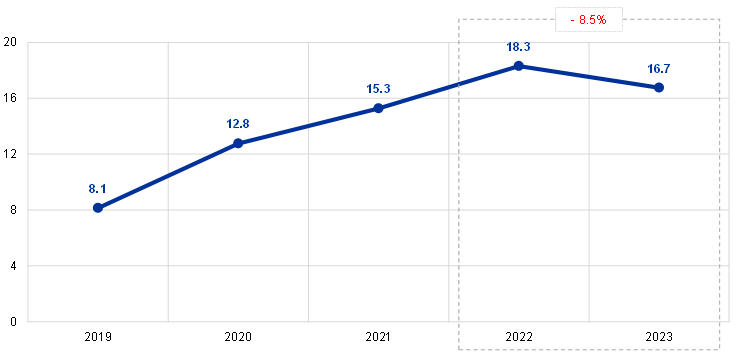
Source: ECB.
Note: The total financial risks as at the end of 2023 were calculated following methodological advances whereby interest rate risk arising from mismatches between the interest rate earned on assets and the interest rate paid on liabilities was also included as a risk contributor in the ES 99% measurement in addition to the regular monitoring of net income projections. The 2022 estimate was recalculated to ensure comparability.

Credit risk arises from the ECB’s monetary policy portfolios, its euro-denominated own funds portfolio and its foreign reserve holdings. While securities held for monetary policy purposes are valued at amortised cost subject to impairment and are therefore, in the absence of sales, not subject to price changes associated with credit migrations, they are still subject to credit default risk. Euro-denominated own funds and foreign reserves are valued at market prices and, as such, are subject to credit migration risk and credit default risk. Credit risk remained largely stable relative to 2022.
Credit risk is mitigated mainly through the application of eligibility criteria, due diligence procedures and limits that differ across portfolios.

Currency and commodity risks arise from the ECB’s foreign currency and gold holdings. The currency risk remained broadly stable compared with 2022.
In view of the policy role of these assets, the ECB does not hedge the related currency and commodity risks. Instead, these risks are mitigated through the existence of revaluation accounts and the diversification of the holdings across different currencies and gold.

The ECB’s foreign reserves and euro-denominated own funds are mainly invested in fixed income securities and are subject to mark-to-market interest rate risk, given that they are valued at market prices. The ECB’s foreign reserves are mainly invested in assets with relatively short maturities (see Chart 7 in Section 1.3.1 “Balance sheet”), while the assets in the own funds portfolio generally have longer maturities (see Chart 9 in Section 1.3.1 “Balance sheet”). The interest rate risk of these portfolios, as measured under the accounting approach, decreased compared to 2022, reflecting developments in market conditions.
The mark-to-market interest rate risk of the ECB is mitigated through asset allocation policies and the revaluation accounts.
The ECB is also subject to interest rate risk arising from mismatches between the interest rate earned on its assets and the interest rate paid on its liabilities, which has an impact on its net interest income. This risk is not directly linked to any particular portfolio but rather to the structure of the ECB’s balance sheet as a whole and, in particular, the existence of maturity and yield mismatches between assets and liabilities. In addition to its inclusion in the regular total financial risk measurement over a one-year horizon, this risk is monitored by means of projections of the ECB’s profitability over a medium to long-term horizon.
This type of risk is managed through asset allocation policies and is further mitigated by the existence of unremunerated liabilities on the ECB’s balance sheet.
This notwithstanding, this risk materialised in 2023, resulting in financial losses being projected over the next few years, after which the ECB is expected to return to making sustained profits. The projected losses are mostly driven by a reduction in the net interest income of the ECB. A large share of the medium to long-term assets with fixed rate coupons were acquired when interest rates were very low or even zero, and funded mainly by short-term liabilities, which are remunerated at the MRO rate. As interest rates started rising in mid-2022, the cost of the liabilities rose above the interest earned on the assets. Consequently, the previous year’s net interest income turned into a net interest expense.

The risks associated with climate change are gradually being incorporated into the ECB’s risk management framework. In 2022 the Eurosystem conducted the first climate stress test of the Eurosystem balance sheet[20], which allowed a preliminary estimate of the impact of this risk on the ECB’s balance sheet to be obtained. In the coming years climate stress testing will be performed on a regular basis, with the next exercise envisaged for 2024.
1.4.2 Operational risk
The Executive Board is responsible for and approves the ECB’s operational risk[21] management (ORM) policy and framework. The Operational Risk Committee (ORC) supports the Executive Board in the performance of its role in overseeing the management of operational risks. ORM is an integral part of the ECB’s governance structure[22] and management processes.
The main objective of the ECB’s ORM framework is to contribute to ensuring that the ECB achieves its mission and objectives, while protecting its reputation and assets against loss, misuse and damage. Under the ORM framework, each business area is responsible for identifying, assessing, responding to, reporting on and monitoring its operational risks, incidents and controls. In this context, the ECB’s risk tolerance policy provides guidance with regard to risk response strategies and risk acceptance procedures. It is linked to a five-by-five risk matrix based on impact and likelihood grading scales using quantitative and qualitative criteria.
The environment in which the ECB operates is exposed to increasingly complex and interconnected threats and there are a wide range of operational risks associated with the ECB’s day-to-day activities. The main areas of concern for the ECB include a wide spectrum of non-financial risks resulting from people, systems, processes and external events. Consequently, the ECB has put in place processes to facilitate ongoing and effective management of its operational risks and to integrate risk information into the decision-making process. Moreover, the ECB is continuing to focus on enhancing its resilience, taking a broad view of risks and opportunities from an end-to-end perspective, including sustainability aspects. Response structures and contingency plans have been established to ensure the continuity of critical business functions in the event of any disruption or crisis.
1.4.3 Conduct risk
The ECB has a dedicated Compliance and Governance Office as a key risk management function to strengthen the ECB’s governance framework in order to address conduct risk.[23] Its purpose is to support the Executive Board in protecting the integrity and reputation of the ECB, to promote ethical standards of behaviour and to strengthen the ECB’s accountability and transparency. An independent Ethics Committee provides advice and guidance to high-level ECB officials on integrity and conduct matters and supports the Governing Council in managing risks at executive level appropriately and coherently. At the level of the Eurosystem and the Single Supervisory Mechanism (SSM), the Ethics and Compliance Committee (ECC) works towards achieving coherent implementation of the conduct frameworks for NCBs and national competent authorities (NCAs).
In 2023 the ECC set up a Conduct Risk Task Force to compare the existing conduct rules and the monitoring and reporting processes in place at the ECB, NCBs and NCAs. The aim of the task force is to define minimum common standards and to provide a simple conduct risk framework which can be extended and strengthened over the years.
2 Financial statements of the ECB
2.1 Balance sheet as at 31 December 2023
ASSETS | Note | 2023 | 2022 |
|---|---|---|---|
Gold and gold receivables | 1 | 30,419 | 27,689 |
Claims on non-euro area residents denominated in foreign currency | 2 | 55,876 | 55,603 |
Receivables from the IMF | 2.1 | 2,083 | 1,759 |
Balances with banks and security investments, external loans and other external assets | 2.2 | 53,793 | 53,844 |
Claims on euro area residents denominated in foreign currency | 2.2 | 1,450 | 1,159 |
Other claims on euro area credit institutions denominated in euro | 3 | 17 | 12 |
Securities of euro area residents denominated in euro | 4 | 425,349 | 457,271 |
Securities held for monetary policy purposes | 4.1 | 425,349 | 457,271 |
Intra-Eurosystem claims | 5 | 125,378 | 125,763 |
Claims related to the allocation of euro banknotes within the Eurosystem | 5.1 | 125,378 | 125,763 |
Other assets | 6 | 34,739 | 31,355 |
Tangible and intangible fixed assets | 6.1 | 1,023 | 1,105 |
Other financial assets | 6.2 | 22,172 | 21,213 |
Off-balance-sheet instruments revaluation differences | 6.3 | 552 | 783 |
Accruals and prepaid expenses | 6.4 | 10,905 | 7,815 |
Sundry | 6.5 | 88 | 438 |
Loss for the year | 1,266 | - | |
Total assets | 674,496 | 698,853 |
Note: Totals in the financial statements and in the tables included in the notes may not add up due to rounding. The figures 0 and (0) indicate positive or negative amounts rounded to zero, while a dash (-) indicates zero.
LIABILITIES | Note | 2023 | 2022 |
|---|---|---|---|
Banknotes in circulation | 7 | 125,378 | 125,763 |
Other liabilities to euro area credit institutions denominated in euro | 8 | 4,699 | 17,734 |
Liabilities to other euro area residents denominated in euro | 9 | 20,622 | 63,863 |
General government | 9.1 | 143 | 48,520 |
Other liabilities | 9.2 | 20,479 | 15,343 |
Liabilities to non-euro area residents denominated in euro | 10 | 23,111 | 78,108 |
Liabilities to non-euro area residents denominated in foreign currency | 11 | 24 | - |
Deposits, balances and other liabilities | 11.1 | 24 | - |
Intra-Eurosystem liabilities | 12 | 445,048 | 355,474 |
Liabilities equivalent to the transfer of foreign reserves | 12.1 | 40,671 | 40,344 |
Other liabilities within the Eurosystem (net) | 12.2 | 404,377 | 315,130 |
Other liabilities | 13 | 9,498 | 5,908 |
Off-balance-sheet instruments revaluation differences | 13.1 | 68 | 430 |
Accruals and income collected in advance | 13.2 | 8,030 | 3,915 |
Sundry | 13.3 | 1,401 | 1,562 |
Provisions | 14 | 67 | 6,636 |
Revaluation accounts | 15 | 37,099 | 36,487 |
Capital and reserves | 16 | 8,948 | 8,880 |
Capital | 16.1 | 8,948 | 8,880 |
Total liabilities | 674,496 | 698,853 |
2.2 Profit and loss account for the year ending 31 December 2023
Note | 2023 | 2022 | |
|---|---|---|---|
Interest income on foreign reserve assets | 23.1 | 2,382 | 798 |
Interest income arising from the allocation of euro banknotes within the Eurosystem | 23.2 | 4,817 | 736 |
Other interest income | 23.4 | 56,552 | 11,001 |
Interest income | 63,751 | 12,536 | |
Remuneration of NCBs’ claims in respect of foreign reserves transferred | 23.3 | (1,335) | (201) |
Other interest expense | 23.4 | (69,609) | (11,434) |
Interest expense | (70,944) | (11,636) | |
Net interest income | 23 | (7,193) | 900 |
Realised gains/losses arising from financial operations | 24 | (106) | (110) |
Write-downs on financial assets and positions | 25 | (38) | (1,840) |
Transfer to/from provisions for financial risks | 6,620 | 1,627 | |
Net result of financial operations, write-downs and risk provisions | 6,476 | (322) | |
Net income/expense from fees and commissions | 26 | 650 | 585 |
Income from equity shares and participating interests | 27 | 1 | 1 |
Other income | 28 | 72 | 61 |
Total net income | 6 | 1,224 | |
Staff costs | 29 | (676) | (652) |
Administrative expenses | 30 | (481) | (460) |
Depreciation of tangible and intangible fixed assets | (106) | (103) | |
Banknote production services | 31 | (9) | (9) |
Profit/(loss) for the year | (1,266) | - |
Frankfurt am Main, 13 February 2024
European Central Bank
Christine Lagarde
President
2.3 Accounting policies
Form and presentation of the financial statements
The financial statements of the ECB have been drawn up in accordance with the following accounting policies,[24] which, in the view of the Governing Council of the ECB, achieve a fair presentation of the financial statements, reflecting at the same time the nature of central bank activities.
Accounting principles
The following accounting principles have been applied: economic reality and transparency, prudence, recognition of post-balance-sheet events, materiality, going concern, the accruals principle, consistency and comparability.
Recognition of assets and liabilities
An asset or liability is only recognised in the balance sheet when it is probable that any associated future economic benefit will flow to or from the ECB, substantially all of the associated risks and rewards have been transferred to the ECB, and the cost or value of the asset or the amount of the obligation can be measured reliably.
Basis of accounting
The accounts have been prepared on a historical cost basis, modified to include the market valuation of marketable securities (other than securities currently held for monetary policy purposes), gold and all other on-balance-sheet and off-balance-sheet assets and liabilities denominated in foreign currency.
Transactions in financial assets and liabilities are reflected in the accounts on the basis of the date on which they were settled.
With the exception of spot transactions in securities, transactions in financial instruments denominated in foreign currency are recorded in off-balance-sheet accounts on the trade date. At the settlement date, the off-balance-sheet entries are reversed, and transactions are booked on-balance-sheet. Purchases and sales of foreign currency affect the net foreign currency position on the trade date, and realised results arising from sales are also calculated on that date. Accrued interest, premiums and discounts related to financial instruments denominated in foreign currency are calculated and recorded daily, and the foreign currency position is also affected daily by these accruals.
Gold and foreign currency assets and liabilities
Assets and liabilities denominated in foreign currency are converted into euro at the exchange rate prevailing on the balance sheet date. Income and expenses are converted at the exchange rate prevailing on the recording date. The revaluation of foreign exchange assets and liabilities, including on-balance-sheet and off-balance-sheet instruments, is performed on a currency-by-currency basis.
Revaluation to the market price for assets and liabilities denominated in foreign currency is treated separately from the exchange rate revaluation.
Gold is valued at the market price prevailing at the balance sheet date. No distinction is made between the price and currency revaluation differences for gold. Instead, a single gold valuation is accounted for on the basis of the price in euro per fine ounce of gold, which, for the year ending 31 December 2023, was derived from the exchange rate of the euro against the US dollar on 29 December 2023.
The special drawing right (SDR) is defined in terms of a basket of currencies and its value is determined by the weighted sum of the exchange rates of five major currencies (the US dollar, euro, Chinese renminbi, Japanese yen and pound sterling). The ECB’s holdings of SDRs were converted into euro using the exchange rate of the euro against the SDR as at 29 December 2023.
Securities
Securities held for monetary policy purposes
Securities currently held for monetary policy purposes are accounted for at amortised cost subject to impairment.
Other securities
Marketable securities (other than securities currently held for monetary policy purposes) and similar assets are valued either at the mid-market prices or on the basis of the relevant yield curve prevailing on the balance sheet date, on a security-by-security basis. Options embedded in securities are not separated for valuation purposes. For the year ending 31 December 2023, mid-market prices on 29 December 2023 were used.
Marketable investment funds are revalued on a net basis at fund level, using their net asset value. No netting is applied between unrealised gains and losses in different investment funds.
Illiquid equity shares and any other equity instruments held as permanent investments are valued at cost subject to impairment.
Income recognition
Income and expenses are recognised in the period in which they are earned or incurred.[25] Realised gains and losses resulting from the sale of foreign currency, gold and securities are recorded in the profit and loss account. Such realised gains and losses are calculated by reference to the average cost of the respective asset.
Unrealised gains are not recognised as income and are transferred directly to a revaluation account.
Unrealised losses are recorded in the profit and loss account if, at the year-end, they exceed previous revaluation gains accumulated in the corresponding revaluation account. Such unrealised losses on any one security or currency or on gold are not netted against unrealised gains on other securities or currencies or gold. In the event of such unrealised losses on any item recorded in the profit and loss account, the average cost of that item is reduced to the year-end exchange rate or market price.
Impairment losses are recorded in the profit and loss account and are not reversed in subsequent years unless the impairment decreases and the decrease can be related to an observable event that occurred after the impairment was first recorded.
Premiums or discounts arising on securities are amortised over the securities’ remaining contractual life.
Reverse transactions
Reverse transactions are operations whereby the ECB buys or sells assets under a repurchase agreement or conducts credit operations against collateral.
Under a repurchase agreement, securities are sold for cash with a simultaneous agreement to repurchase them from the counterparty at an agreed price on a set future date. Repurchase agreements are recorded as collateralised deposits on the liability side of the balance sheet. Securities sold under such an agreement remain on the balance sheet of the ECB.
Under a reverse repurchase agreement, securities are bought for cash with a simultaneous agreement to sell them back to the counterparty at an agreed price on a set future date. Reverse repurchase agreements are recorded as collateralised loans on the asset side of the balance sheet, but are not included in the ECB’s security holdings.
Reverse transactions (including securities lending transactions) conducted under a programme offered by a specialised institution are recorded on the balance sheet only where collateral has been provided in the form of cash and this cash remains uninvested.
Off-balance-sheet instruments
Currency instruments, namely foreign exchange forward transactions, forward legs of foreign exchange swaps and other currency instruments involving an exchange of one currency for another at a future date, are included in the net foreign currency position for the purpose of calculating foreign exchange gains and losses.
Interest rate instruments are revalued on an item-by-item basis. Daily changes in the variation margin of open interest rate futures contracts are recorded in the profit and loss account. The valuation of forward transactions in securities is carried out by the ECB based on generally accepted valuation methods using observable market prices and rates, as well as discount factors from the settlement dates to the valuation date.
Fixed assets
Fixed assets, including intangible assets, but excluding land and works of art, are valued at cost less depreciation. Land and works of art are valued at cost. The ECB’s main building is valued at cost less depreciation subject to impairment. For the depreciation of the ECB’s main building, costs are assigned to the appropriate asset components, which are depreciated in accordance with their estimated useful lives. Depreciation is calculated on a straight-line basis over the expected useful life of the asset, beginning in the quarter after the asset is available for use. The useful lives applied for the main asset classes are as follows:
Buildings | 20, 25 or 50 years |
Plant in building | 10 or 15 years |
Technical equipment | 4, 10 or 15 years |
Computers, related hardware and software, and motor vehicles | 4 years |
Furniture | 10 years |
The depreciation period for capitalised refurbishment expenditure relating to the ECB’s existing rented premises is adjusted to take account of any events that have an impact on the expected useful life of the affected asset.
The ECB performs an annual impairment test of its main building and right-of-use assets relating to office buildings (see “Leases” below). If an impairment indicator is identified, and it is assessed that the asset may be impaired, the recoverable amount is estimated. An impairment loss is recorded in the profit and loss account if the recoverable amount is less than the net book value.
Fixed assets costing less than €10,000 are written off in the year of acquisition.
Fixed assets that comply with the capitalisation criteria, but are still under construction or development, are recorded under the heading “Assets under construction”. The related costs are transferred to the relevant fixed asset headings once the assets are available for use.
Leases
The ECB acts both as a lessee and a sub-lessor.
The ECB as a lessee
For all leases for which the ECB is a lessee and which involve a tangible asset, the related right-of-use asset and lease liability are recognised on the balance sheet at the lease commencement date, i.e. once the asset is available for use, and are included under the relevant fixed asset headings of “Tangible and intangible fixed assets” and under “Sundry” (liabilities) respectively. Where leases comply with the capitalisation criteria, but the asset involved is still under construction or adaptation, the incurred costs before the lease commencement date are recorded under the heading “Assets under construction”.
Right-of-use assets are valued at cost less depreciation. In addition, right-of-use assets relating to office buildings are subject to impairment (regarding the annual impairment test, see “Fixed assets” above). Depreciation is calculated on a straight-line basis from the commencement date to either the end of the useful life of the right-of-use asset or the end of the lease term, whichever is earlier.
The lease liability is initially measured at the present value of the future lease payments (comprising only lease components), discounted using the ECB's incremental borrowing rate. Subsequently, the lease liability is measured at amortised cost using the effective interest method. The related interest expense is recorded in the profit and loss account under “Other interest expense”. When there is a change in future lease payments arising from a change in an index or other reassessment of the existing contract, the lease liability is remeasured. Any such remeasurement results in a corresponding adjustment to the carrying amount of the right-of-use asset.
Short-term leases with a duration of 12 months or less and leases of low-value assets below €10,000 (consistent with the threshold used for the recognition of fixed assets) are recorded as an expense in the profit and loss account.
The ECB as a sub-lessor
For all leases for which the ECB is a sub-lessor, the ECB grants to third parties the right to use the underlying asset (or a part of such asset), while the lease between the original lessor and the ECB (head lease) remains in effect. The sub-lease is classified as a finance or operating lease[26] by reference to the right-of-use asset arising from the head lease, rather than by reference to the underlying asset.
The sub-leases for which the ECB is a sub-lessor are classified as a finance lease and the ECB derecognises from “Tangible and intangible fixed assets” the right-of-use asset relating to the head lease (or a part of such asset) that is transferred to the sub-lessee, and recognises under “Sundry” (assets) a sub-lease receivable. The lease liability relating to the head lease remains unaffected by the sub-lease.
At the commencement date, the sub-lease receivable is initially measured at the present value of the future lease payments accruing to the ECB, discounted using the discount rate used for the head lease. Subsequently, the sub-lease receivable is measured at amortised cost using the effective interest method. The related interest income is recorded in the profit and loss account under “Other interest income”.
The ECB’s post-employment benefits, other long-term benefits and termination benefits
The ECB operates defined benefit plans for its staff and the members of the Executive Board, as well as for the members of the Supervisory Board employed by the ECB.
The staff pension plan is funded by assets held in a long-term employee benefit fund. The compulsory contributions made by the ECB and the staff are reflected in the defined benefit pillar of the plan. Staff can make additional contributions on a voluntary basis in a defined contribution pillar that can be used to provide additional benefits.[27] These additional benefits are determined by the amount of voluntary contributions together with the investment returns arising from those contributions.
Unfunded arrangements are in place for the post-employment and other long-term benefits of members of the Executive Board and members of the Supervisory Board employed by the ECB. For staff, unfunded arrangements are in place for post-employment benefits other than pensions and for other long-term benefits.
Net defined benefit liability
The liability recognised in the balance sheet under “Sundry” (liabilities) in respect of the defined benefit plans, including other long-term benefits and termination benefits[28], is the present value of the defined benefit obligation at the balance sheet date, less the fair value of plan assets used to fund the related obligation.
The defined benefit obligation is calculated annually by independent actuaries using the projected unit credit method. The present value of the defined benefit obligation is calculated by discounting the estimated future cash flows using a rate which is determined by reference to market yields at the balance sheet date on high-quality euro-denominated corporate bonds that have similar terms to maturity to the related obligation.
Actuarial gains and losses can arise from experience adjustments (where actual outcomes are different from the actuarial assumptions previously made) and changes in actuarial assumptions.
Net defined benefit cost
The net defined benefit cost is split into components reported in the profit and loss account and remeasurements in respect of post-employment benefits shown in the balance sheet under “Revaluation accounts”.
The net amount charged to the profit and loss account comprises:
- the current service cost of the defined benefits accruing for the year;
- the past service cost of the defined benefits resulting from a plan amendment;
- net interest at the discount rate on the net defined benefit liability;
- remeasurements in respect of other long-term benefits and termination benefits of a long-term nature[29], if any, in their entirety.
The net amount shown under “Revaluation accounts” comprises the following items:
- actuarial gains and losses on the defined benefit obligation;
- the actual return on plan assets, excluding amounts included in the net interest on the net defined benefit liability;
- any change in the effect of the asset ceiling, excluding amounts included in the net interest on the net defined benefit liability.
These amounts are valued annually by independent actuaries to establish the appropriate liability in the financial statements.
Intra-ESCB balances/intra-Eurosystem balances
Intra-ESCB balances result primarily from cross-border payments in the European Union (EU) that are settled in central bank money in euro. These transactions are for the most part initiated by private entities (i.e. credit institutions, corporations and individuals). They are settled in TARGET – the Trans-European Automated Real-time Gross settlement Express Transfer system – and give rise to bilateral balances in the TARGET accounts of EU central banks. Payments conducted by the ECB and the national central banks (NCBs) also affect these accounts. All settlements are automatically aggregated and adjusted to form part of a single position for each NCB vis-à-vis the ECB. These positions in the books of the ECB represent the net claim or liability of each NCB against the rest of the European System of Central Banks (ESCB). The movements in TARGET accounts are reflected in the accounting records of the ECB and the NCBs on a daily basis.
Intra-Eurosystem balances of euro area NCBs vis-à-vis the ECB arising from TARGET, as well as other intra-Eurosystem balances denominated in euro (e.g. the ECB’s interim profit distribution to NCBs, if any), are presented on the balance sheet of the ECB as a single net asset or liability position under either “Other claims within the Eurosystem (net)” or “Other liabilities within the Eurosystem (net)”. Intra-ESCB balances of non-euro area NCBs vis-à-vis the ECB, arising from their participation in TARGET,[30] are disclosed under “Liabilities to non-euro area residents denominated in euro”.
Intra-Eurosystem balances arising from the allocation of euro banknotes within the Eurosystem are included as a single net asset under “Claims related to the allocation of euro banknotes within the Eurosystem” (see “Banknotes in circulation” below).
Intra-Eurosystem balances arising from the transfer of foreign reserve assets to the ECB by NCBs joining the Eurosystem are denominated in euro and reported under “Liabilities equivalent to the transfer of foreign reserves”.
Banknotes in circulation
The ECB and the euro area NCBs, which together constitute the Eurosystem, issue euro banknotes.[31] The total value of euro banknotes in circulation is allocated to the Eurosystem central banks on the last working day of each month in accordance with the banknote allocation key.[32]
The ECB has been allocated an 8% share of the total value of euro banknotes in circulation, which is disclosed in the balance sheet under the liability item “Banknotes in circulation”. The ECB’s share of the total euro banknote issue is backed by claims on the NCBs. These claims, which bear interest,[33] are disclosed under the item “Claims related to the allocation of euro banknotes within the Eurosystem” (see “Intra-ESCB balances/intra-Eurosystem balances” above). Interest income on these claims is included in the profit and loss account under the item “Interest income arising from the allocation of euro banknotes within the Eurosystem”.
Interim profit distribution
An amount that is equal to the sum of the ECB’s income on euro banknotes in circulation and income arising from the securities held for monetary policy purposes purchased under (i) the Securities Markets Programme; (ii) the third covered bond purchase programme; (iii) the asset-backed securities purchase programme; (iv) the public sector purchase programme; and (v) the pandemic emergency purchase programme is distributed in January of the following year by means of an interim profit distribution, unless otherwise decided by the Governing Council.[34] Any such decision shall be taken where, on the basis of a reasoned estimate prepared by the Executive Board, the Governing Council expects that the ECB will have an overall annual loss or will make an annual profit that is less than this income. The Governing Council may also decide to transfer all or part of this income to a provision for financial risks. Furthermore, the Governing Council may decide to reduce the amount of the income on euro banknotes in circulation to be distributed in January by the amount of the costs incurred by the ECB in connection with the issue and handling of euro banknotes.
Post-balance-sheet events
The values of assets and liabilities are adjusted for events that occur between the annual balance sheet date and the date on which the Executive Board authorises the submission of the ECB’s Annual Accounts to the Governing Council for approval, if such events materially affect the condition of assets and liabilities at the balance sheet date.
Important post-balance-sheet events that do not affect the condition of assets and liabilities at the balance sheet date are disclosed in the notes.
Changes to accounting policies
In 2023 there were no changes to the accounting policies applied by the ECB.
Other issues
In accordance with Article 27 of the Statute of the ESCB, and on the basis of a recommendation of the Governing Council, the Council of the EU initially approved the appointment of Baker Tilly GmbH & Co. KG Wirtschaftsprüfungsgesellschaft, Düsseldorf (Federal Republic of Germany) as the external auditors of the ECB for a five-year period up to the end of the financial year 2022. In 2023 the Council of the EU, based on a recommendation by the Governing Council, approved an extension of this period by two additional years until the end of the financial year 2024.
2.4 Notes on the balance sheet
Note 1 - Gold and gold receivables
This item comprised the ECB’s holdings of gold:
2023 | 2022 | |
|---|---|---|
Quantity | ||
Ounces of fine gold1 | 16,285,778 | 16,229,522 |
Price | ||
US dollar per fine ounce of gold | 2,063.950 | 1,819.700 |
US dollar per euro | 1.1050 | 1.0666 |
Market value (€ millions) | 30,419 | 27,689 |
1) This corresponds to 506.5 and 504.8 tonnes in 2023 and 2022 respectively.
The increase in the euro equivalent value of ECB’s gold holdings was primarily due to the rise in the market price of gold in euro terms (see “Gold and foreign currency assets and liabilities” in Section 2.3 “Accounting policies” and note 15 “Revaluation accounts”). Additionally, upon the adoption of the single currency by Croatia with effect from 1 January 2023, Hrvatska narodna banka transferred to the ECB 56,256 ounces of fine gold with a value of €96 million.
Note 2 - Claims on non-euro area and euro area residents denominated in foreign currency
Note 2.1 - Receivables from the IMF
This asset represents the ECB’s holdings of SDRs and amounted to €2,083 million as at 31 December 2023 (2022: €1,759 million). It arises as the result of a two-way SDR buying and selling voluntary trading arrangement with the International Monetary Fund (IMF), whereby the IMF is authorised to arrange sales or purchases of SDRs against euro, on behalf of the ECB, within minimum and maximum holding levels. For accounting purposes, SDRs are treated as a foreign currency (see “Gold and foreign currency assets and liabilities” in Section 2.3 “Accounting policies”). The ECB’s holdings of SDRs increased in 2023, predominantly as a result of a transaction that took place in the context of the above-mentioned voluntary trading arrangement.
Note 2.2 - Balances with banks and security investments, external loans and other external assets; and claims on euro area residents denominated in foreign currency
These two items consist of balances with banks and loans denominated in foreign currency, and investments in securities denominated in US dollars, Japanese yen and Chinese renminbi.
2023 | 2022 | Change | |
|---|---|---|---|
Claims on non-euro area residents | |||
Current accounts | 7,161 | 15,687 | (8,526) |
Money market deposits | 474 | 985 | (512) |
Security investments | 46,158 | 37,172 | 8,986 |
Total claims on non-euro area residents | 53,793 | 53,844 | (52) |
Claims on euro area residents | |||
Current accounts | 25 | 34 | (10) |
Money market deposits | 1,426 | 1,125 | 301 |
Total claims on euro area residents | 1,450 | 1,159 | 291 |
Total | 55,243 | 55,004 | 239 |
The total value of these items increased in 2023, mainly owing to the income earned during the year, primarily on the US dollar portfolio. Additionally, upon the adoption of the single currency by Croatia with effect from 1 January 2023, Hrvatska narodna banka transferred to the ECB foreign reserve assets denominated in US dollars with a value of €544 million. However, the total increase was almost entirely offset by the depreciation of the US dollar and the Japanese yen against the euro.
The ECB’s net foreign currency holdings[35] were as follows:
2023 | 2022 | |
|---|---|---|
US dollars | 52,590 | 49,590 |
Japanese yen | 1,089,844 | 1,090,312 |
Chinese renminbi | 4,545 | 4,440 |
No foreign exchange interventions took place during 2023.
Note 3 - Other claims on euro area credit institutions denominated in euro
As at 31 December 2023 this item consisted of current account balances with euro area residents amounting to €17 million (2022: €12 million).
Note 4 - Securities of euro area residents denominated in euro
Note 4.1 - Securities held for monetary policy purposes
As at 31 December 2023 this item consisted of securities acquired by the ECB within the scope of the Securities Markets Programme (SMP), the third covered bond purchase programme (CBPP3), the asset-backed securities purchase programme (ABSPP), the public sector purchase programme (PSPP) and the pandemic emergency purchase programme (PEPP).
Start date | End date | Decision | Universe of eligible securities1 | |
|---|---|---|---|---|
Completed/Terminated programmes | ||||
CBPP12 | July 2009 | June 2010 | ECB/2009/16 | Covered bonds of euro area residents |
CBPP22 | November 2011 | October 2012 | ECB/2011/17 | Covered bonds of euro area residents |
SMP | May 2010 | September 2012 | ECB/2010/5 | Public and private debt securities issued in the euro area3 |
Asset purchase programme (APP)4 | ||||
CBPP3 | October 2014 | active | ECB/2020/8, | Covered bonds of euro area residents |
ABSPP | November 2014 | active | ECB/2014/45, | Senior and guaranteed mezzanine tranches of asset-backed securities of euro area residents |
PSPP | March 2015 | active | ECB/2020/9 | Bonds issued by euro area central, regional or local governments or recognised agencies as well as by international organisations and multilateral development banks located in the euro area |
CSPP5 | June 2016 | active | ECB/2016/16, | Bonds and commercial paper issued by non-bank corporations established in the euro area |
Pandemic emergency purchase programme (PEPP) | ||||
PEPP | March 2020 | active | ECB/2020/17, | All asset categories eligible under the APP |
1) Further eligibility criteria for the specific programmes can be found in the Governing Council’s decisions.
2) At the end of 2022 and the end of 2023, the ECB did not have any holdings of securities under the first and second covered bond purchase programmes (CBPP1 and CBPP2). However, in 2022 the ECB still recorded interest income from these portfolios, since the last holdings under the CBPP1 and the CBPP2 matured in July 2022 and September 2022 respectively.
3) Only public debt securities issued by five euro area treasuries were purchased under the SMP.
4) The reinvestments under the asset purchase programme (APP) were discontinued as of 1 July 2023.
5) The ECB does not acquire securities under the corporate sector purchase programme (CSPP).
Until the end of February 2023[36], the Eurosystem continued reinvesting, in full, the principal payments from maturing securities purchased under the asset purchase programme (APP)[37]. Subsequently, the APP portfolio declined at a measured and predictable pace. Until the end of June 2023, the decline amounted to €15 billion per month on average, as the Eurosystem did not reinvest all of the principal payments from maturing securities. In June 2023 the Governing Council decided[38] to discontinue the reinvestments under the APP as of July 2023. Thereafter, the APP portfolio declined due to maturing securities.
With regard to the PEPP[39], the Eurosystem continued reinvesting, in full, the principal payments from maturing securities purchased throughout the year. The Governing Council intends[40] to continue to reinvest, in full, the principal payments from maturing securities purchased under the PEPP during the first half of 2024. It also intends to reduce the PEPP portfolio by €7.5 billion per month on average over the second half of 2024 and to discontinue reinvestments at the end of the same year. In addition, the Governing Council will continue applying flexibility in reinvesting redemptions coming due in the PEPP portfolio, with a view to countering risks to the monetary policy transmission mechanism related to the pandemic.
The securities purchased under these programmes are valued on an amortised cost basis subject to impairment (see “Securities” in Section 2.3 “Accounting policies”).
The amortised cost of the securities held by the ECB and their market value[41] (which is not recorded on the balance sheet or in the profit and loss account and is provided for comparison purposes only) were as follows:
2023 | 2022 | Change | ||||
|---|---|---|---|---|---|---|
Amortised | Market | Amortised | Market | Amortised | Market | |
Completed/Terminated programmes | ||||||
SMP | 496 | 522 | 718 | 766 | (222) | (244) |
APP | ||||||
CBPP3 | 23,530 | 21,490 | 25,116 | 22,136 | (1,587) | (647) |
ABSPP | 13,348 | 13,225 | 22,895 | 22,605 | (9,547) | (9,379) |
PSPP – government/agency securities | 224,867 | 205,847 | 242,857 | 213,750 | (17,991) | (7,903) |
Total APP | 261,744 | 240,562 | 290,868 | 258,491 | (29,124) | (17,930) |
PEPP | ||||||
PEPP – covered bonds | 839 | 736 | 769 | 628 | 70 | 108 |
PEPP – government/agency securities | 162,270 | 143,669 | 164,916 | 138,072 | (2,646) | 5,597 |
Total PEPP | 163,109 | 144,405 | 165,685 | 138,700 | (2,576) | 5,705 |
Total | 425,349 | 385,489 | 457,271 | 397,957 | (31,922) | (12,468) |
The amortised cost value of the securities held by the ECB changed during the year as follows:
2022 | Gross purchases | Redemptions | Net discount/ | 2023 | |
|---|---|---|---|---|---|
SMP | 718 | - | (235) | 13 | 496 |
CBPP3 | 25,116 | 1,512 | (3,057) | (42) | 23,530 |
ABSPP | 22,895 | 690 | (10,142) | (95) | 13,348 |
PSPP – government/agency securities | 242,857 | 10,141 | (26,160) | (1,971) | 224,867 |
PEPP – covered bonds | 769 | 85 | (15) | (1) | 839 |
PEPP – government/agency securities | 164,916 | 17,220 | (17,922) | (1,945) | 162,270 |
Total | 457,271 | 29,649 | (57,530) | (4,041) | 425,349 |
1) "Net discount/(premium)" includes net realised gains/(losses), if any.
The Governing Council assesses on a regular basis the financial risks associated with the securities held under these programmes.
In this context, impairment tests are conducted on an annual basis, using data as at the year-end, and are approved by the Governing Council. In these tests, impairment indicators are assessed separately for each programme. In cases where impairment indicators are observed, further analysis is performed to confirm that the cash flows of the underlying securities have not been affected by an impairment event. Based on the results of this year’s impairment tests, no losses have been recorded by the ECB for the securities held in its monetary policy portfolios in 2023.
The amortised cost value of the securities held by the Eurosystem was as follows:
2023 | 2022 | |||||
|---|---|---|---|---|---|---|
ECB | Euro area NCBs | Total Eurosystem | ECB | Euro area NCBs | Total Eurosystem | |
Completed/Terminated programmes | ||||||
SMP | 496 | 1,901 | 2,397 | 718 | 2,143 | 2,860 |
APP | ||||||
CBPP3 | 23,530 | 262,090 | 285,620 | 25,116 | 276,857 | 301,973 |
ABSPP | 13,348 | - | 13,348 | 22,895 | - | 22,895 |
PSPP – government/agency securities | 224,867 | 1,922,907 | 2,147,774 | 242,857 | 2,066,581 | 2,309,438 |
PSPP – supranational securities | - | 255,261 | 255,261 | - | 275,228 | 275,228 |
CSPP | - | 323,921 | 323,921 | - | 344,119 | 344,119 |
Total APP | 261,744 | 2,764,180 | 3,025,924 | 290,868 | 2,962,785 | 3,253,653 |
PEPP | ||||||
PEPP – covered bonds | 839 | 5,197 | 6,036 | 769 | 5,283 | 6,052 |
PEPP – government/agency securities | 162,270 | 1,297,397 | 1,459,667 | 164,916 | 1,317,937 | 1,482,853 |
PEPP – supranational securities | - | 154,332 | 154,332 | - | 145,687 | 145,687 |
PEPP – corporate sector securities | - | 45,989 | 45,989 | - | 46,074 | 46,074 |
Total PEPP | 163,109 | 1,502,915 | 1,666,024 | 165,685 | 1,514,981 | 1,680,666 |
Total | 425,349 | 4,268,996 | 4,694,345 | 457,271 | 4,479,908 | 4,937,179 |
Note: “Euro area NCBs” figures are preliminary and may be subject to revision, which would also result in an equivalent change in the “Total Eurosystem” figures.
Note 5 - Intra-Eurosystem claims
Note 5.1 - Claims related to the allocation of euro banknotes within the Eurosystem
This item consists of the claims of the ECB vis-à-vis the euro area NCBs relating to the allocation of euro banknotes within the Eurosystem (see “Banknotes in circulation” in Section 2.3 “Accounting policies”) and as at 31 December 2023 amounted to €125,378 million (2022: €125,763 million). The remuneration of these claims is calculated daily at the latest available interest rate used by the Eurosystem in its tenders for main refinancing operations (see note 23.2 “Interest income arising from the allocation of euro banknotes within the Eurosystem”).
Note 6 - Other assets
Note 6.1 - Tangible and intangible fixed assets
These assets comprised the following items:
2023 | 2022 | Change | |
|---|---|---|---|
Cost | |||
Land and buildings | 1,014 | 1,007 | 7 |
Right-of-use buildings | 315 | 296 | 19 |
Plant in building | 222 | 222 | - |
Computer hardware and software | 142 | 140 | 1 |
Equipment, furniture and motor vehicles | 111 | 110 | 1 |
Right-of-use equipment | 2 | 3 | (1) |
Assets under construction | 0 | 5 | (5) |
Other fixed assets | 11 | 11 | (0) |
Total cost | 1,818 | 1,796 | 22 |
Accumulated depreciation | |||
Land and buildings | (227) | (204) | (23) |
Right-of-use buildings | (197) | (152) | (45) |
Plant in building | (144) | (128) | (16) |
Computer hardware and software | (129) | (120) | (9) |
Equipment, furniture and motor vehicles | (92) | (82) | (11) |
Right-of-use equipment | (2) | (2) | (0) |
Other fixed assets | (3) | (3) | (0) |
Total accumulated depreciation | (795) | (690) | (104) |
Total net book value | 1,023 | 1,105 | (82) |
In respect of the ECB’s main building and right-of-use office buildings, an impairment test was conducted at the end of the year and no impairment loss was recorded.
Note 6.2 - Other financial assets
This item consists mainly of the ECB’s own funds portfolio, which predominantly consists of investments of the ECB’s paid-up capital as well as of amounts set aside in the general reserve fund and in the provision for financial risks. It also includes 3,211 shares in the Bank for International Settlements (BIS) at the acquisition cost of €42 million and other current accounts denominated in euro.
The components of this item were as follows:
2023 | 2022 | Change | |
|---|---|---|---|
Current accounts in euro | 46 | 38 | 8 |
Securities denominated in euro | 20,355 | 19,280 | 1,075 |
Reverse repurchase agreements in euro | 1,730 | 1,854 | (124) |
Other financial assets | 42 | 42 | (0) |
Total | 22,172 | 21,213 | 959 |
The net increase in this item in 2023 was primarily due to (i) the reinvestment of interest income generated on the ECB’s own funds portfolio and (ii) the increase in the market value of euro-denominated securities held in this portfolio.
Note 6.3 - Off-balance-sheet instruments revaluation differences
This item is composed primarily of valuation changes in swap and forward transactions in foreign currency that were outstanding on 31 December 2023 (see note 20 “Foreign exchange swap and forward transactions”). These valuation changes amounted to €552 million (2022: €783 million) and are the result of the conversion of such transactions into their euro equivalents at the exchange rates prevailing on the balance sheet date, compared with the euro values resulting from the conversion of the transactions at the average cost of the respective foreign currency on that date (see “Off-balance-sheet instruments” and “Gold and foreign currency assets and liabilities” in Section 2.3 “Accounting policies”).
Note 6.4 - Accruals and prepaid expenses
This item comprised the following components:
2023 | 2022 | Change | |
|---|---|---|---|
Accrued interest on TARGET balances due from NCBs | 4,955 | 2,856 | 2,099 |
Accrued interest on claims related to the allocation of euro banknotes | 1,429 | 575 | 855 |
Accrued interest on securities | 3,709 | 3,640 | 69 |
Accrued income related to supervisory tasks | 654 | 594 | 60 |
Other accruals and prepaid expenses | 158 | 151 | 7 |
Total | 10,905 | 7,815 | 3,090 |
As at 31 December 2023 this item included accrued interest receivable on TARGET balances due from euro area NCBs for December 2023 (see note 12.2 “Other liabilities within the Eurosystem (net)”) and accrued interest receivable from euro area NCBs for the final quarter of 2023 in respect of the ECB’s claims related to the allocation of euro banknotes within the Eurosystem (see note 5.1 “Claims related to the allocation of euro banknotes within the Eurosystem”). These amounts were settled in January 2024.
It also included accrued coupon interest on securities, including outstanding interest paid at acquisition (see note 2.2 “Balances with banks and security investments, external loans and other external assets; and claims on euro area residents denominated in foreign currency”, note 4 “Securities of euro area residents denominated in euro” and note 6.2 “Other financial assets”).
Accrued income related to supervisory tasks corresponds to the supervisory fees to be received for the fee period 2023 that will be collected in 2024 (see note 26 “Net income/expense from fees and commissions”).[42]
The remainder of this item mainly comprised (i) accrued interest income on other financial instruments; (ii) accrued income from ESCB projects and services in operation (see note 28 “Other income”); and (iii) miscellaneous prepayments.
Note 6.5 - Sundry
On 31 December 2023 this item amounted to €88 million (2022: €438 million). It included miscellaneous balances amounting to €60 million (2022: €90 million), comprising mainly receivables in relation to ESCB projects and services in operation (see note 28 “Other income”) and balances in respect of recoverable value added tax.
It also included balances with a value of €28 million (2022: €349 million) related to swap and forward transactions in foreign currency outstanding on 31 December 2023 (see note 20 “Foreign exchange swap and forward transactions”). These balances arose from the conversion of such transactions into their euro equivalents at the respective currency’s average cost on the balance sheet date, compared with the euro values at which the transactions were initially recorded (see “Off-balance-sheet instruments” in Section 2.3 “Accounting policies”).
Note 7 - Banknotes in circulation
This item consists of the ECB’s share (8%) of total euro banknotes in circulation (see “Banknotes in circulation” in Section 2.3 “Accounting policies”), which as at 31 December 2023 amounted to €125,378 million (2022: €125,763 million).
Note 8 - Other liabilities to euro area credit institutions denominated in euro
The Eurosystem central banks have the possibility of accepting cash as collateral in their PSPP and public sector PEPP securities lending facilities without having to reinvest it. In the case of the ECB, these operations are conducted via a specialised institution.
As at 31 December 2023 the outstanding value of such lending transactions against cash collateral conducted with euro area credit institutions was €4,699 million (2022: €17,734 million). Cash received as collateral was transferred to TARGET accounts. As the cash remained uninvested at the year-end, these transactions were recorded on the balance sheet (see “Reverse transactions” in Section 2.3 “Accounting policies”).[43]
Note 9 - Liabilities to other euro area residents denominated in euro
Note 9.1 - General government
As at 31 December 2023 this item amounted to €143 million (2022: €48,520 million) and included deposits of the European Financial Stability Facility (EFSF) and the European Stability Mechanism (ESM). In accordance with Article 21 of the Statute of the ESCB, the ECB may act as fiscal agent for Union institutions, bodies, offices or agencies, central governments, regional, local or other public authorities, other bodies governed by public law, or public undertakings of Member States.
Note 9.2 - Other liabilities
This item consists of balances of the euro area ancillary systems[44] connected to TARGET through the TARGET-ECB component, which as at 31 December 2023 amounted to €20,479 million (2022: €15,343 million).
Note 10 - Liabilities to non-euro area residents denominated in euro
This item comprised the following components:
2023 | 2022 | Change | |
|---|---|---|---|
TARGET balances | 3,854 | 42,808 | (38,954) |
Cash received as collateral in securities lending transactions | 5,637 | 15,008 | (9,372) |
Deposits accepted by the ECB in its role as fiscal agent | 12,383 | 19,904 | (7,522) |
Liquidity-providing swap arrangements | 1,237 | 388 | 850 |
Total | 23,111 | 78,108 | (54,997) |
As at 31 December 2023 the largest component of this item was deposits accepted by the ECB in its role as fiscal agent for the European Commission, relating to the administration of EU borrowing and lending activities (see note 21 “Administration of borrowing and lending operations”).
This item also included balances arising from outstanding PSPP and public sector PEPP securities lending transactions conducted with non-euro area credit institutions in which cash was received as collateral and transferred to TARGET accounts (see note 8 “Other liabilities to euro area credit institutions denominated in euro”).
Furthermore, it included TARGET balances, consisting of TARGET balances of non-euro area NCBs vis-à-vis the ECB (see “Intra-ESCB balances/intra-Eurosystem balances” in Section 2.3 “Accounting policies”) and of the non-euro area ancillary systems connected to TARGET through the TARGET-ECB component. The decrease in these balances in 2023 corresponds to lower balances of the non-euro area ancillary systems.
The remainder of this item consists of a balance arising from the standing reciprocal currency arrangement with the Federal Reserve System. Under this arrangement, US dollars are provided by the Federal Reserve Bank of New York to the ECB by means of swap transactions, with the aim of offering short-term US dollar funding to Eurosystem counterparties. The ECB simultaneously enters into back-to-back swap transactions with euro area NCBs, which use the resulting funds to conduct US dollar liquidity-providing operations with Eurosystem counterparties in the form of reverse transactions. The back-to-back swap transactions result in intra-Eurosystem balances between the ECB and the euro area NCBs. Furthermore, the swap transactions conducted with the Federal Reserve Bank of New York and the euro area NCBs result in forward claims and liabilities that are recorded in off-balance-sheet accounts (see note 20 “Foreign exchange swap and forward transactions”).
Note 11 - Liabilities to non-euro area residents denominated in foreign currency
Note 11.1 - Deposits, balances and other liabilities
As at 31 December 2023 this item consisted of a liability in foreign currency vis-à-vis a non-euro area resident amounting to €24 million (2022: zero), which arose in the context of the management of the ECB’s foreign reserves.
Note 12 - Intra-Eurosystem liabilities
Note 12.1 - Liabilities equivalent to the transfer of foreign reserves
These represent the liabilities to euro area NCBs that arose from the transfer of foreign reserve assets to the ECB when they joined the Eurosystem. In line with Article 30.2 of the Statute of the ESCB, these contributions are fixed in proportion to the NCBs’ shares in the subscribed capital of the ECB. Hrvatska narodna banka’s transfer of foreign reserve assets upon Croatia’s adoption of the single currency led to an increase in these liabilities.
Since | As at | |
|---|---|---|
Nationale Bank van België/Banque Nationale de Belgique (Belgium) | 1,470 | 1,470 |
Deutsche Bundesbank (Germany) | 10,635 | 10,635 |
Eesti Pank (Estonia) | 114 | 114 |
Central Bank of Ireland (Ireland) | 683 | 683 |
Bank of Greece (Greece) | 998 | 998 |
Banco de España (Spain) | 4,811 | 4,811 |
Banque de France (France) | 8,240 | 8,240 |
Hrvatska narodna banka (Croatia) | 327 | - |
Banca d’Italia (Italy) | 6,854 | 6,854 |
Central Bank of Cyprus (Cyprus) | 87 | 87 |
Latvijas Banka (Latvia) | 157 | 157 |
Lietuvos bankas (Lithuania) | 233 | 233 |
Banque centrale du Luxembourg (Luxembourg) | 133 | 133 |
Central Bank of Malta (Malta) | 42 | 42 |
De Nederlandsche Bank (The Netherlands) | 2,364 | 2,364 |
Oesterreichische Nationalbank (Austria) | 1,181 | 1,181 |
Banco de Portugal (Portugal) | 944 | 944 |
Banka Slovenije (Slovenia) | 194 | 194 |
Národná banka Slovenska (Slovakia) | 462 | 462 |
Suomen Pankki – Finlands Bank (Finland) | 741 | 741 |
Total | 40,671 | 40,344 |
Hrvatska narodna banka’s claim was set at €327 million in order to ensure that the ratio between this claim and the aggregate claim credited to the other NCBs of Member States whose currency is the euro would be equal to the ratio between Hrvatska narodna banka’s weighting in the ECB’s capital key and the other euro area NCBs’ aggregate weighting in this key. The difference between the claim and the value of the assets transferred (see note 1 “Gold and gold receivables” and note 2.2 “Balances with banks and security investments, external loans and other external assets; and claims on euro area residents denominated in foreign currency”) was treated as part of the contributions from Hrvatska narodna banka, due under Article 48.2 of the Statute of the ESCB, to the reserves and provisions equivalent to the reserves of the ECB as at 31 December 2022 (see note 14 “Provisions” and note 15 “Revaluation accounts”).
The remuneration of these liabilities is calculated daily at the latest available interest rate used by the Eurosystem in its tenders for main refinancing operations, adjusted to reflect a zero return on the gold component (see note 23.3 “Remuneration of NCBs’ claims in respect of foreign reserves transferred”).
Note 12.2 - Other liabilities within the Eurosystem (net)
In 2023 this item consisted predominantly of the TARGET balances of euro area NCBs vis-à-vis the ECB (see “Intra-ESCB balances/intra-Eurosystem balances” in Section 2.3 “Accounting policies”).
2023 | 2022 | |
|---|---|---|
Net TARGET liability | 404,336 | 315,090 |
Due to euro area NCBs in respect of TARGET | 1,616,387 | 1,830,483 |
Due from euro area NCBs in respect of TARGET | (1,212,050) | (1,515,393) |
Other liabilities within the Eurosystem | 40 | 41 |
Total | 404,377 | 315,130 |
The increase in the net TARGET liability was mainly attributable to the cash outflows as a result of (i) lower deposits of the ESM and the EFSF (see note 9.1 “General government”); (ii) lower balances of the non-euro area ancillary systems connected to TARGET through the TARGET-ECB component (see note 10 “Liabilities to non-euro area residents denominated in euro”); and (iii) the decrease in cash received as collateral against the lending of PSPP and public sector PEPP securities (see note 8 “Other liabilities to euro area credit institutions denominated in euro” and note 10 “Liabilities to non-euro area residents denominated in euro”). The impact of these factors was partially offset mainly by the cash inflows as a result of the maturing of securities under the APP and the PEPP, which were settled via TARGET accounts (see note 4 “Securities of euro area residents denominated in euro”).
The remuneration of TARGET positions held by euro area NCBs vis-à-vis the ECB, with the exception of balances arising from back-to-back swap transactions in connection with US dollar liquidity-providing operations, is calculated daily at the latest available interest rate used by the Eurosystem in its tenders for main refinancing operations.
Other liabilities within the Eurosystem comprised predominantly deposits accepted by the ECB in its role as fiscal agent for the European Commission, relating to the administration of EU borrowing and lending activities (see note 21 “Administration of borrowing and lending operations”).
Note 13 - Other liabilities
Note 13.1 - Off-balance-sheet instruments revaluation differences
This item is composed primarily of valuation changes in swap and forward transactions in foreign currency that were outstanding on 31 December 2023 (see note 20 “Foreign exchange swap and forward transactions”). These valuation changes amounted to €68 million (2022: €430 million) and are the result of the conversion of such transactions into their euro equivalents at the exchange rates prevailing on the balance sheet date, compared with the euro values resulting from the conversion of the transactions at the average cost of the respective foreign currency on that date (see “Off-balance-sheet instruments” and “Gold and foreign currency assets and liabilities” in Section 2.3 “Accounting policies”).
Note 13.2 - Accruals and income collected in advance
This item comprised the following components:
2023 | 2022 | Change | |
|---|---|---|---|
Accrued interest on TARGET balances due to NCBs | 6,390 | 3,530 | 2,860 |
Accrued interest on NCBs’ claims in respect of foreign reserves transferred to the ECB | 1,335 | 201 | 1,133 |
Accrued interest on deposits accepted by the ECB in its role as fiscal agent | 172 | 94 | 78 |
Other accruals and deferred income | 134 | 90 | 43 |
Total | 8,030 | 3,915 | 4,114 |
As at 31 December 2023 the two main components under this heading were accrued interest payable on TARGET balances due to NCBs for December 2023 (see note 10 “Liabilities to non-euro area residents denominated in euro” and note 12.2 “Other liabilities within the Eurosystem (net)”) and accrued interest payable to euro area NCBs for 2023 in respect of their claims relating to foreign reserves transferred to the ECB (see note 12.1 “Liabilities equivalent to the transfer of foreign reserves”). These amounts were settled in January 2024.
This item also included accrued interest payable on deposits accepted by the ECB in its role as fiscal agent (see note 9.1 “General government”, note 10 “Liabilities to non-euro area residents denominated in euro” and note 12.2 “Other liabilities within the Eurosystem (net)”).
The remainder of this item included mainly (i) accrued interest payable on balances of the euro area ancillary systems connected to TARGET through the TARGET-ECB component (see note 9.2 “Other liabilities”); (ii) miscellaneous accruals and deferred income; and (iii) accrued interest payable on cash received as collateral in the context of the ECB’s securities lending operations (note 8 “Other liabilities to euro area credit institutions denominated in euro” and note 10 “Liabilities to non-euro area residents denominated in euro”).
Note 13.3 - Sundry
On 31 December 2023 this item stood at €1,401 million (2022: €1,562 million). It included balances amounting to €635 million (2022: €974 million) related to swap and forward transactions in foreign currency that were outstanding on 31 December 2023 (see note 20 “Foreign exchange swap and forward transactions”). These balances arose from the conversion of such transactions into their euro equivalents at the respective currency’s average cost on the balance sheet date, compared with the euro values at which the transactions were initially recorded (see “Off-balance-sheet instruments” in Section 2.3 “Accounting policies”).
The item also includes a lease liability of €117 million (2022: €141 million) (see “Leases” in Section 2.3 “Accounting policies”).
In addition, this item includes the ECB’s net defined benefit liability in respect of the post-employment and other long-term benefits of its staff[45] and the members of the Executive Board, as well as the members of the Supervisory Board employed by the ECB. The termination benefits of ECB staff are also included.
The ECB’s post-employment benefits, other long-term benefits and termination benefits
Balance sheet
The amounts recognised in the balance sheet under the item “Sundry” (liabilities) in respect of post-employment, other long-term and staff termination benefits[46] were as follows:
2023 | 2022 | |||||
|---|---|---|---|---|---|---|
Staff | Boards | Total | Staff | Boards | Total | |
Defined benefit obligation | 2,458 | 35 | 2,493 | 1,947 | 31 | 1,978 |
Fair value of plan assets | (1,983) | - | (1,983) | (1,638) | - | (1,638) |
Net defined benefit liability included under “Sundry” (liabilities) | 475 | 35 | 510 | 309 | 31 | 340 |
Note: The columns labelled “Boards” report amounts in respect of both the Executive Board and the Supervisory Board.
In 2023 the present value of the defined benefit obligation vis-à-vis staff of €2,458 million (2022: €1,947 million) included unfunded benefits amounting to €278 million (2022: €233 million) relating to post-employment benefits other than pensions and to other long-term benefits. The present value of the defined benefit obligation vis-à-vis the members of the Executive Board and the members of the Supervisory Board of €35 million (2022: €31 million) relates solely to unfunded arrangements in place for post-employment and other long-term benefits.
Remeasurements of the ECB’s net defined benefit liability in respect of post-employment benefits are recognised in the balance sheet under the liability item “Revaluation accounts”. In 2023 remeasurement gains under that liability item amounted to €238 million (2022: €369 million) (see note 15 “Revaluation accounts”).
Changes in the defined benefit obligation, plan assets and remeasurement results
Changes in the present value of the defined benefit obligation were as follows:
2023 | 2022 | |||||
|---|---|---|---|---|---|---|
Staff | Boards | Total | Staff | Boards | Total | |
Opening defined benefit obligation | 1,947 | 31 | 1,978 | 3,165 | 43 | 3,209 |
Current service cost | 101 | 2 | 103 | 164 | 4 | 168 |
Interest cost on the obligation | 77 | 1 | 79 | 42 | 1 | 42 |
Contributions paid by plan participants1 | 36 | 0 | 36 | 40 | 0 | 41 |
Benefits paid | (30) | (3) | (33) | (38) | (2) | (40) |
Remeasurement (gains)/losses | 327 | 4 | 331 | (1,426) | (16) | (1,441) |
Closing defined benefit obligation | 2,458 | 35 | 2,493 | 1,947 | 31 | 1,978 |
Note: The columns labelled “Boards” report amounts in respect of both the Executive Board and the Supervisory Board.
1) Net figure including compulsory contributions and transfers into/out of the plans. The compulsory contributions paid by staff are 7.4%, whilst those paid by the ECB are 20.7% of the basic salary.
The total remeasurement losses of €331 million on the defined benefit obligation in 2023 arose mainly as a result of the decrease in the discount rate used for the actuarial valuation from 3.9% in 2022 to 3.4% in 2023.
Changes in the fair value of plan assets in the defined benefit pillar relating to staff were as follows:
2023 | 2022 | |
|---|---|---|
Opening fair value of plan assets | 1,638 | 1,749 |
Interest income on plan assets | 66 | 23 |
Remeasurement gains/(losses) | 189 | (228) |
Contributions paid by employer | 75 | 71 |
Contributions paid by plan participants | 36 | 40 |
Benefits paid | (20) | (18) |
Closing fair value of plan assets | 1,983 | 1,638 |
The remeasurement gains on plan assets in 2023 reflected the fact that the actual return on the fund units was higher than the assumed interest income on plan assets, which was based on the discount rate assumption of 3.9%.
Changes in the remeasurement results were as follows:
2023 | 2022 | |
|---|---|---|
Opening remeasurement gains/(losses) | 369 | (799) |
Contributions by NCBs joining the Eurosystem1 | 3 | - |
Gains/(losses) on plan assets | 189 | (228) |
Gains/(losses) on obligation | (331) | 1,441 |
(Gains)/losses recognised in the profit and loss account | 8 | (45) |
Closing remeasurement gains included under “Revaluation accounts” | 238 | 369 |
1) Upon the adoption of the single currency by Croatia, Hrvatska narodna banka contributed to the balances of all the revaluation accounts of the ECB as at 31 December 2022, which also included the remeasurement gains outstanding as of that date.
Profit and loss account
The amounts recognised in the profit and loss account were as follows:
2023 | 2022 | |||||
|---|---|---|---|---|---|---|
Staff | Boards | Total | Staff | Boards | Total | |
Current service cost | 101 | 2 | 103 | 164 | 4 | 168 |
Net interest on the net defined benefit liability | 12 | 1 | 13 | 19 | 1 | 19 |
Interest cost on the obligation | 77 | 1 | 79 | 42 | 1 | 42 |
Interest income on plan assets | (66) | - | (66) | (23) | - | (23) |
Remeasurement (gains)/losses on other | 8 | (0) | 8 | (44) | (0) | (45) |
Total included in “Staff costs” | 121 | 3 | 124 | 138 | 5 | 142 |
Note: The columns labelled “Boards” report amounts in respect of both the Executive Board and the Supervisory Board.
The amounts recognised in the profit and loss account for the current service cost, interest cost on the obligation and interest income on plan assets are estimated using the rates that applied in the preceding year. The discount rate used for the actuarial valuation rose from 1.3% in 2021 to 3.9% in 2022, resulting in 2023 in (i) lower current service cost, (ii) higher interest cost on the obligation, and (iii) higher interest income on plan assets.
The remeasurements on other long-term and termination benefits are recognised in the profit and loss account of the current year, reflecting the rates applicable to the valuation. Therefore, the lower discount rate of 3.4% used for the actuarial valuation at the end of 2023 resulted in a remeasurement loss recognised in that year.
Key assumptions
In preparing the valuations referred to in this note, the independent actuaries have used assumptions which the Executive Board has accepted for the purposes of accounting and disclosure. The principal assumptions used for the purposes of calculating the liability for post-employment benefits and other long-term benefits were as follows:
2023 | 2022 | |
|---|---|---|
Discount rate | 3.40 | 3.90 |
Expected return on plan assets1 | 5.30 | 4.90 |
General future salary increases2 | 2.00 | 2.00 |
Future pension increases3 | 1.70 | 1.70 |
1) These assumptions were used for calculating the part of the ECB’s defined benefit obligation which is funded by assets with an underlying capital guarantee.
2) In addition, allowance is made for prospective individual salary increases of up to 1.8% per annum, depending on the age of the plan participants.
3) In accordance with the ECB’s pension plan rules, pensions will be increased annually. If general salary adjustments for ECB employees are below price inflation, any increase in pensions will be in line with the general salary adjustments. If the general salary adjustments exceed price inflation, they will be applied to determine the increase in pensions, provided that the financial position of the ECB’s pension plans permits such an increase.
Note 14 - Provisions
As at 31 December 2023 this item included administrative provisions amounting to €67 million (2022: €69 million). At the end of 2022 this item also included a provision for financial risks amounting to €6,566 million. Upon Croatia’s adoption of the single currency, Hrvatska narodna banka contributed €53 million to this provision with effect from 1 January 2023[47], increasing its size to €6,620 million.
The size of and continuing requirement for the provision for financial risks is reviewed annually, based on the ECB’s assessment of its exposure to these risks and taking a range of factors into account. Its size, together with any amount held in the general reserve fund, may not exceed the value of the ECB’s capital paid up by the euro area NCBs. The purpose of this provision is to be used to the extent deemed necessary by the Governing Council to offset losses that arise as a result of exposures to financial risks. At the end of 2023 this provision was released in full to cover losses that arose from exposures to financial risks, bringing the ECB’s loss for the year to €1,266 million. The losses resulted mainly from the increase in the interest rate used by the Eurosystem in its tenders for main refinancing operations, which led to a significant interest expense arising from the ECB’s net TARGET liability (see note 23.4 “Other interest income; and other interest expense”).
As a result of the full release of this provision for financial risks, its size stood at zero as at 31 December 2023. The Governing Council, in the context of its annual review, may decide to replenish this provision, once the ECB returns to making a profit.
Note 15 - Revaluation accounts
This item consists mainly of revaluation balances arising from unrealised gains on assets, liabilities and off-balance-sheet instruments (see “Income recognition”, “Gold and foreign currency assets and liabilities”, “Securities” and “Off-balance-sheet instruments” in Section 2.3 “Accounting policies”). It also includes remeasurements of the ECB’s net defined benefit liability in respect of post-employment benefits (see “The ECB’s post-employment benefits, other long-term benefits and termination benefits” in Section 2.3 “Accounting policies” and note 13.3 “Sundry”).
2023 | 2022 | Change | |
|---|---|---|---|
Gold | 26,622 | 23,794 | 2,827 |
Foreign currency | 9,842 | 12,305 | (2,462) |
US dollars | 9,624 | 11,225 | (1,601) |
Japanese yen | 206 | 977 | (771) |
Chinese renminbi | 9 | 47 | (38) |
SDR | 4 | 56 | (52) |
Others | 0 | - | 0 |
Securities and other instruments | 397 | 19 | 378 |
Net defined benefit liability in respect of post‑employment benefits | 238 | 369 | (131) |
Total | 37,099 | 36,487 | 611 |
The revaluation accounts increased in 2023 predominantly due to the rise in the market price of gold in euro terms. Additionally, upon Croatia’s adoption of the single currency, Hrvatska narodna banka contributed €296 million to these balances with effect from 1 January 2023. This increase was partially offset by a decrease in the size of the foreign currency revaluation accounts, mainly owing to the depreciation of the US dollar and the Japanese yen against the euro.
The foreign exchange rates used for the year-end revaluation were as follows:
Exchange rates | 2023 | 2022 |
|---|---|---|
US dollar per euro | 1.1050 | 1.0666 |
Japanese yen per euro | 156.33 | 140.66 |
Chinese renminbi per euro | 7.8509 | 7.3582 |
Euro per SDR | 1.2157 | 1.2517 |
Euro per fine ounce of gold | 1,867.828 | 1,706.075 |
Note 16 - Capital and reserves
Note 16.1 - Capital
The subscribed capital of the ECB is €10,825 million.
Croatia adopted the single currency on 1 January 2023. In accordance with Article 48.1 of the Statute of the ESCB, Hrvatska narodna banka paid up €69 million as at 1 January 2023[48], representing the remainder of its capital subscription to the ECB. As a consequence, the ECB’s total paid-up capital increased from €8,880 million on 31 December 2022 to €8,948 million on 1 January 2023, as shown in the table below.
Since 1 January 2023 | As at 31 December 2022 | |||||
|---|---|---|---|---|---|---|
Capital key | Subscribed capital | Paid-up capital | Capital key | Subscribed capital | Paid-up capital | |
Nationale Bank van België/ | 2.9630 | 321 | 321 | 2.9630 | 321 | 321 |
Deutsche Bundesbank (Germany) | 21.4394 | 2,321 | 2,321 | 21.4394 | 2,321 | 2,321 |
Eesti Pank (Estonia) | 0.2291 | 25 | 25 | 0.2291 | 25 | 25 |
Central Bank of Ireland (Ireland) | 1.3772 | 149 | 149 | 1.3772 | 149 | 149 |
Bank of Greece (Greece) | 2.0117 | 218 | 218 | 2.0117 | 218 | 218 |
Banco de España (Spain) | 9.6981 | 1,050 | 1,050 | 9.6981 | 1,050 | 1,050 |
Banque de France (France) | 16.6108 | 1,798 | 1,798 | 16.6108 | 1,798 | 1,798 |
Hrvatska narodna banka (Croatia) | 0.6595 | 71 | 71 | - | - | - |
Banca d’Italia (Italy) | 13.8165 | 1,496 | 1,496 | 13.8165 | 1,496 | 1,496 |
Central Bank of Cyprus (Cyprus) | 0.1750 | 19 | 19 | 0.1750 | 19 | 19 |
Latvijas Banka (Latvia) | 0.3169 | 34 | 34 | 0.3169 | 34 | 34 |
Lietuvos bankas (Lithuania) | 0.4707 | 51 | 51 | 0.4707 | 51 | 51 |
Banque centrale du Luxembourg (Luxembourg) | 0.2679 | 29 | 29 | 0.2679 | 29 | 29 |
Central Bank of Malta (Malta) | 0.0853 | 9 | 9 | 0.0853 | 9 | 9 |
De Nederlandsche Bank | 4.7662 | 516 | 516 | 4.7662 | 516 | 516 |
Oesterreichische Nationalbank (Austria) | 2.3804 | 258 | 258 | 2.3804 | 258 | 258 |
Banco de Portugal (Portugal) | 1.9035 | 206 | 206 | 1.9035 | 206 | 206 |
Banka Slovenije (Slovenia) | 0.3916 | 42 | 42 | 0.3916 | 42 | 42 |
Národná banka Slovenska (Slovakia) | 0.9314 | 101 | 101 | 0.9314 | 101 | 101 |
Suomen Pankki – Finlands Bank (Finland) | 1.4939 | 162 | 162 | 1.4939 | 162 | 162 |
Subtotal for euro area NCBs | 81.9881 | 8,875 | 8,875 | 81.3286 | 8,804 | 8,804 |
Българска народна банка | 0.9832 | 106 | 4 | 0.9832 | 106 | 4 |
Česká národní banka (Czech Republic) | 1.8794 | 203 | 8 | 1.8794 | 203 | 8 |
Danmarks Nationalbank (Denmark) | 1.7591 | 190 | 7 | 1.7591 | 190 | 7 |
Hrvatska narodna banka (Croatia) | - | - | - | 0.6595 | 71 | 3 |
Magyar Nemzeti Bank (Hungary) | 1.5488 | 168 | 6 | 1.5488 | 168 | 6 |
Narodowy Bank Polski (Poland) | 6.0335 | 653 | 24 | 6.0335 | 653 | 24 |
Banca Naţională a României (Romania) | 2.8289 | 306 | 11 | 2.8289 | 306 | 11 |
Sveriges Riksbank (Sweden) | 2.9790 | 322 | 12 | 2.9790 | 322 | 12 |
Subtotal for non-euro area NCBs | 18.0119 | 1,950 | 73 | 18.6714 | 2,021 | 76 |
Total | 100.0000 | 10,825 | 8,948 | 100.0000 | 10,825 | 8,880 |
The euro area NCBs have fully paid up their share of subscribed capital.
The non-euro area NCBs are required to pay up 3.75% of their subscribed capital as a contribution to the operational costs of the ECB. Non-euro area NCBs are not entitled to receive any share of the distributable profits of the ECB, nor are they liable to cover any loss of the ECB.
2.5 Off-balance-sheet instruments
Note 17 - Securities lending programmes
As part of the management of the ECB’s own funds, the ECB has a securities lending programme agreement in place under which a specialised institution enters into securities lending transactions on behalf of the ECB.
In addition, in accordance with the Governing Council’s decisions, the ECB has made available for lending securities held for monetary policy purposes.[49]
Unless these securities lending operations are conducted against cash collateral that remains uninvested at the end of the year, they are recorded in off-balance-sheet accounts.[50] Such securities lending operations with a value of €32,791 million (2022: €11,569 million) were outstanding as at 31 December 2023. Of this amount, €26,577 million (2022: €6,637 million) related to the lending of securities held for monetary policy purposes.
Note 18 - Interest rate futures
The following transactions, presented at year-end foreign exchange rates, were outstanding:
Foreign currency interest rate futures | 2023 | 2022 | Change |
|---|---|---|---|
Purchases | 2,207 | 692 | 1,515 |
Sales | 4,142 | 1,401 | 2,741 |
These transactions were conducted in the context of the management of the ECB’s foreign reserves.
Note 19 - Forward transactions in securities
The following transactions, presented at year-end foreign exchange rates, were outstanding:
Forward transactions in securities | 2023 | 2022 | Change |
|---|---|---|---|
Purchases | 45 | - | 45 |
Sales | 45 | - | 45 |
These transactions were conducted in the context of the management of the ECB’s foreign reserves.
Note 20 - Foreign exchange swap and forward transactions
Management of foreign reserves
Foreign exchange swap and forward transactions were conducted in the context of the management of the ECB’s foreign reserves. The outstanding claims and liabilities resulting from these transactions, presented at year-end foreign exchange rates, were as follows:
Foreign exchange swap and forward transactions | 2023 | 2022 | Change |
|---|---|---|---|
Claims | 2,778 | 3,269 | (491) |
Liabilities | 2,901 | 3,541 | (639) |
Liquidity-providing swap arrangements
The ECB is part of a swap-line network of central banks and has in place reciprocal swap arrangements with the Bank of Canada, the Bank of England, the Bank of Japan, the Federal Reserve System and the Swiss National Bank. It also holds a reciprocal swap-line with the People’s Bank of China. These swap arrangements allow for the provision of (i) liquidity in any of the respective currencies of the above-mentioned central banks to euro area banks; or (ii) euro liquidity to financial institutions in the jurisdictions of the above central banks. Furthermore, swap agreements are also in place with Danmarks Nationalbank, Narodowy Bank Polski and Sveriges Riksbank for the provision of euro liquidity to financial institutions in their jurisdictions. The above arrangements are aimed at addressing possible liquidity needs to counter potential market dysfunction and thereby minimise the risk of adverse spillover effects to euro area financial markets and economies.[51]
US dollar-denominated claims and liabilities with a maturity date in 2024 arose in connection with the provision of US dollar liquidity to Eurosystem counterparties (see note 10 “Liabilities to non-euro area residents denominated in euro”).
Note 21 - Administration of borrowing and lending operations
In 2023 the ECB continued to be responsible for the administration of accounts and processing of payments relating to the borrowing and lending operations of the EU under the medium-term financial assistance facility, the European Financial Stabilisation Mechanism and the loan facility agreement for Greece.
In response to the COVID-19 pandemic, the EU granted loans to the Member States under its instrument for temporary Support to mitigate Unemployment Risks in an Emergency (SURE). The availability of this instrument ended on 31 December 2022, but the relevant issuances consisted of bonds ranging from 5 to 30 years maturity. In 2023 the EU also continued to provide financing in the form of non-repayable financial support and loan support to Member States under the Next Generation EU (NGEU) programme, which was established to support the economic recovery in the EU, while facilitating the green and digital transition of the Union’s economy. In 2023 the EU also provided support to Ukraine in the form of loans through a new macro-financial assistance instrument (MFA +). The ECB supported the European Commission in the administration of the operations related to the above-mentioned instruments.
In 2023 the ECB processed payments related to all the above-mentioned operations.
Note 22 - Contingent liabilities from pending lawsuits
Lawsuits have been filed against the ECB relating to the exercise of its supervisory functions over Banca Carige S.p.A. (Banca Carige). In one of these lawsuits, Banca Carige’s shareholders are seeking financial compensation from the ECB for the harm allegedly sustained as a result of various actions by the ECB in the exercise of its supervisory functions in respect of Banca Carige, consisting both of alleged failures to act and harmful actions. This case will be decided taking into account, among other factors, the final outcome of other related cases. In one of them, the General Court of the EU deemed, in its judgment of 12 October 2022, that the ECB’s decision to place Banca Carige under temporary administration lacked an appropriate legal basis under Italian law. Accordingly, the General Court annulled the ECB’s decision to place Banca Carige under temporary administration as well as the first extension of the duration of temporary administration in 2019. However, the General Court’s judgment was appealed by the ECB before the Court of Justice of the EU, which may still overturn that judgment. Moreover, two further ECB decisions extending the temporary administration are currently being contested in an action for annulment, which is still pending.
2.6 Notes on the profit and loss account
Note 23 - Net interest income
2023 | 2022 | Change | |
|---|---|---|---|
Net interest income on foreign reserve assets | 2,382 | 798 | 1,583 |
Interest income arising from the allocation of euro banknotes within the Eurosystem | 4,817 | 736 | 4,081 |
Remuneration of NCBs’ claims in respect of foreign reserves transferred | (1,335) | (201) | (1,133) |
Net other interest expense | (13,057) | (433) | (12,624) |
Net interest income | (7,193) | 900 | (8,093) |
Note 23.1 - Interest income on foreign reserve assets
This item includes interest income, net of interest expense, in respect of the ECB’s net foreign reserve assets.
The net interest income/expense per instrument type is shown below:
2023 | 2022 | Change | |
|---|---|---|---|
Current accounts | 82 | 22 | 60 |
Money market deposits | 129 | 51 | 78 |
Repurchase agreements | - | (0) | 0 |
Reverse repurchase agreements | 271 | 148 | 122 |
Securities | 1,745 | 513 | 1,232 |
Forward and swap transactions in foreign currencies | 155 | 64 | 91 |
Net interest income on foreign reserve assets | 2,382 | 798 | 1,583 |
The net interest income/expense per foreign currency was as follows:
2023 | 2022 | Change | |
|---|---|---|---|
US dollars | 2,298 | 771 | 1,527 |
Japanese yen | (2) | (4) | 2 |
Chinese renminbi | 13 | 14 | (0) |
SDR | 73 | 18 | 54 |
Net interest income on foreign reserve assets | 2,382 | 798 | 1,583 |
Note 23.2 - Interest income arising from the allocation of euro banknotes within the Eurosystem
This item consists of the interest income relating to the ECB’s 8% share of the total euro banknote issue (see “Banknotes in circulation” in Section 2.3 “Accounting policies” and note 5.1 “Claims related to the allocation of euro banknotes within the Eurosystem”). The interest income in 2023 amounted to €4,817 million (2022: €736 million). The increase in this income resulted from the higher average rate on the main refinancing operations in 2023 compared with the previous year (3.8% in 2023, compared with 0.6% in 2022).
Note 23.3 - Remuneration of NCBs’ claims in respect of foreign reserves transferred
Remuneration paid to euro area NCBs on their claims in respect of the foreign reserve assets transferred to the ECB (see note 12.1 “Liabilities equivalent to the transfer of foreign reserves”) is disclosed under this heading. The interest expense in 2023 amounted to €1,335 million (2022: €201 million). The increase in this remuneration was due to the higher average rate on the main refinancing operations in 2023 compared with the previous year (3.8% in 2023, compared with 0.6% in 2022).
Note 23.4 - Other interest income; and other interest expense
Other interest income and other interest expense were as follows:
2023 | 2022 | Change | |
|---|---|---|---|
Net interest expense arising from TARGET balances due from/to NCBs | (14,236) | (2,075) | (12,161) |
Net interest income/(expense) on monetary policy securities | 3,467 | 1,534 | 1,933 |
CBPP1 and CBPP2 | - | 2 | (2) |
SMP1 | 49 | 65 | (16) |
CBPP3 | 179 | 120 | 59 |
ABSPP | 642 | 140 | 502 |
PSPP | 1,997 | 1,310 | 686 |
PEPP | 600 | (103) | 703 |
Net interest income/(expense) on monetary policy security lending2 | (308) | 80 | (388) |
Net interest income on own funds | 627 | 57 | 571 |
Net interest expense on deposits accepted by the ECB in its role as fiscal agent | (1,953) | (150) | (1,803) |
Net interest income/(expense) on other assets/liabilities | (655) | 121 | (776) |
Net other interest expense | (13,057) | (433) | (12,624) |
1) The ECB’s net interest income on SMP holdings of Greek government bonds amounted to €31 million (2022: €43 million).
2) Net interest income/(expense) on monetary policy security lending also includes the interest income/(expense) on cash received as collateral.
Note 24 - Realised gains/losses arising from financial operations
Realised gains and losses arising from financial operations were as follows:
2023 | 2022 | Change | |
|---|---|---|---|
Net realised price losses | (117) | (351) | 234 |
Net realised exchange rate and gold price gains | 11 | 241 | (230) |
Net realised losses arising from financial operations | (106) | (110) | 4 |
Net realised price losses include realised gains and losses on securities and interest rate futures. The net realised price losses in 2023 mainly arose from the accounting treatment of premium and discount amortisation related to repayments of securities held in the ABSPP.[52]
Realised gains and losses arising from financial operations per currency and per quarter are shown below:
2023 | 2022 | |||||||||
|---|---|---|---|---|---|---|---|---|---|---|
Q1 | Q2 | Q3 | Q4 | Total | Q1 | Q2 | Q3 | Q4 | Total | |
Net realised price gains/(losses) | ||||||||||
US dollars | 41 | 22 | (64) | (20) | (21) | (9) | (87) | (76) | (88) | (260) |
Japanese yen | (5) | 4 | (1) | (4) | (5) | (1) | (3) | 1 | (2) | (4) |
Chinese renminbi | 0 | 0 | 0 | (0) | 0 | 2 | 2 | 2 | 0 | 6 |
Euro | (42) | (21) | (16) | (12) | (91) | (34) | (40) | (9) | (9) | (92) |
Subtotal | (5) | 4 | (81) | (35) | (117) | (42) | (128) | (82) | (99) | (351) |
Net realised exchange rate and gold price gains/(losses) | ||||||||||
US dollars | 0 | 2 | 1 | 5 | 8 | 9 | 20 | 15 | 192 | 236 |
Japanese yen | 2 | 0 | 0 | 0 | 2 | 1 | 1 | 0 | 3 | 4 |
Chinese renminbi | 0 | (0) | 0 | (0) | 0 | 0 | 0 | 0 | 0 | 0 |
Other | 0 | 0 | 0 | 0 | 0 | 0 | 0 | (0) | 0 | 0 |
Subtotal | 2 | 3 | 1 | 5 | 11 | 10 | 21 | 15 | 195 | 241 |
Total | (3) | 7 | (80) | (30) | (106) | (32) | (107) | (67) | 96 | (110) |
Note 25 - Write-downs on financial assets and positions
Write-downs on financial assets and positions were as follows:
2023 | 2022 | Change | |
|---|---|---|---|
Unrealised price losses on securities | (38) | (1,840) | 1,802 |
Unrealised exchange rate losses | - | (0) | 0 |
Write-downs on financial assets and positions | (38) | (1,840) | 1,802 |
The market value of a number of securities held in the US dollar and own funds portfolios declined, alongside an increase in the corresponding yields in 2023. This resulted in unrealised price losses at the year-end. In 2022 these losses were substantially higher, because the corresponding yields had increased significantly, resulting in a large reduction in the market value of the majority of securities held in these portfolios at the end of that year.
Note 26 - Net income/expense from fees and commissions
2023 | 2022 | Change | |
|---|---|---|---|
Income from fees and commissions | 672 | 606 | 66 |
Expenses relating to fees and commissions | (22) | (21) | (1) |
Net income from fees and commissions | 650 | 585 | 65 |
Income under this heading consists primarily of supervisory fees. Expenses comprise predominantly custody fees.
Income and expenses related to supervisory tasks
Banking supervision-related income mainly comprises supervisory fee income. The ECB levies annual fees on supervised entities in order to recover expenditure incurred in the performance of its supervisory tasks. Based on the ECB’s actual annual expenses incurred in the performance of its banking supervision tasks, the supervisory fee income for 2023 stood at €654 million (2022: €594 million).
In order to determine the amount of supervisory fees to be levied, the actual annual expenditure is adjusted for amounts reimbursed to/received from individual banks for previous fee periods and other adjustments, including interest received on late payments.[53] Taking into account an adjustment corresponding to interest received on late payments as well as net reimbursements to individual banks for previous fee periods, the annual supervisory fees to be levied on the supervised entities for the fee period 2023 correspond to an amount almost equal to the actual annual expenses of €654 million[54] (see note 6.4 “Accruals and prepaid expenses”). The individual supervisory fees will be invoiced in the second quarter of 2024.[55]
The ECB is also entitled to impose administrative penalties on supervised entities for failure to comply with applicable EU banking law on prudential requirements (including ECB supervisory decisions). The related income is not considered in the calculation of the annual supervisory fees, nor are reimbursements of such penalties in the event that previous sanction decisions are amended or annulled. Instead, the related amounts are recorded in the ECB’s profit and loss account. In 2023 the income arising from penalties on supervised entities amounted to €18 million (2022: €12 million).
Thus, the income of the ECB for supervisory tasks was as follows:
2023 | 2022 | Change | |
|---|---|---|---|
Income from supervisory fees | 654 | 594 | 60 |
Fee income from significant entities or significant groups | 626 | 567 | 59 |
Fee income from less significant entities or less significant groups | 27 | 27 | 0 |
Imposed administrative penalties | 18 | 12 | 6 |
Income related to banking supervision tasks | 671 | 606 | 65 |
Banking supervision-related expenses result from the direct supervision of significant entities, the oversight of the supervision of less significant entities and the performance of horizontal tasks and specialised services. They consist of the direct expenses of the ECB’s supervisory function and the relevant expenses arising from support areas needed to fulfil the ECB’s supervisory responsibilities, reflecting their services in relation to premises and facilities; human resources; information technology (IT); legal, audit and administration; communication and translation; as well as other activities.
The actual expenses relating to the ECB’s supervisory tasks, which are recovered via the annual supervisory fees for 2023, amounted to €654 million (2022: €594 million). The overall increase was driven by higher staff costs in 2023. In the previous year, the staff costs were lessened by actuarial gains considered in relation to other long-term benefits owing to the significantly higher discount rate used for the actuarial valuation at the end of 2022[56]. In 2023 the higher average number of staff working for ECB Banking Supervision as well as salary adjustments also contributed to the rise in staff costs. Besides the higher staff costs, the return to full levels of activity in banking supervision following the pandemic also contributed to the overall increase in expenses relating to supervisory tasks.
Note 27 - Income from equity shares and participating interests
The dividend of €1 million in 2023 (2022: €1 million) received on shares which the ECB holds in the BIS (see note 6.2 “Other financial assets”) is shown under this heading.
Note 28 - Other income
Other miscellaneous income in 2023 stood at €72 million (2022: €61 million) and arose mainly from contributions of participating NCBs to costs incurred by the ECB in connection with ESCB projects and services in operation.
Note 29 - Staff costs
Staff costs were as follows:
2023 | 2022 | Change | |
|---|---|---|---|
Salaries and allowances1 | 528 | 487 | 41 |
Staff insurance | 25 | 23 | 2 |
Post-employment, other long-term and termination benefits | 124 | 142 | (19) |
Staff costs | 676 | 652 | 25 |
1) Salaries and allowances are, in essence, modelled on, and comparable with, the remuneration scheme of the EU.
The average number of employees, expressed in full-time equivalents (FTEs)[57], amounted to 4,222 (2022: 4,136), of which 380 were managerial staff (2022: 373).
Salaries and allowances increased as a result of the higher average number of staff employed by the ECB, predominantly in banking supervision, as well as the salary adjustments. This increase was partially offset by lower costs in relation to post-employment benefits, resulting mainly from a higher discount rate used in the actuarial valuation to derive the current service cost for 2023[58] (see note 13.3 “Sundry”).
Remuneration of the Executive and Supervisory Boards
Members of the Executive Board and the members of the Supervisory Board employed by the ECB receive a basic salary and a residence allowance. In the case of the President, a residence is provided in lieu of a residence allowance. Members of the Executive Board and the Chair of the Supervisory Board also receive a representation allowance. Subject to the Conditions of Employment for Staff of the European Central Bank, members of both boards may be entitled to household, child, education and other allowances, depending on their individual circumstances. Salaries are subject to a tax for the benefit of the EU, as well as to deductions in respect of contributions to the pension, medical, long-term care and accident insurance schemes. Allowances are non-taxable and non-pensionable.
In 2023 the basic salaries of the members of the Executive Board and members of the Supervisory Board employed by the ECB (i.e. excluding representatives of national supervisors) were as follows:[59]
2023 | 2022 | |
|---|---|---|
Christine Lagarde (President) | 444,984 | 427,560 |
Luis de Guindos Jurado (Vice-President) | 381,444 | 366,504 |
Philip R. Lane (Board Member) | 317,856 | 305,400 |
Fabio Panetta (Board Member until 31 October 2023) | 264,880 | 305,400 |
Isabel Schnabel (Board Member) | 317,856 | 305,400 |
Frank Elderson (Board Member) | 317,856 | 305,400 |
Piero Cipollone (Board Member since 1 November 2023) | 52,976 | - |
Total Executive Board | 2,097,852 | 2,015,664 |
Total Supervisory Board (members employed by the ECB)1 | 1,374,853 | 1,225,887 |
of which: | ||
Andrea Enria (Chair of the Supervisory Board) | 317,856 | 305,400 |
Total | 3,472,705 | 3,241,551 |
1) The total figure includes the remuneration of the Chair of the Supervisory Board and of four ECB representatives. Frank Elderson does not receive any additional remuneration in his role as Vice-Chair of the Supervisory Board. The totals for 2022 were affected by a time gap between the end and start, respectively, of the terms of office of Pentti Hakkarainen and his successor Anneli Tuominen, whereas in 2023 all ECB members of the Supervisory Board were in office throughout the year.
Total allowances paid to members of both boards and the ECB’s contributions to medical, long-term care and accident insurance schemes on their behalf amounted to €1,169,703 (2022: €1,110,618).
Transitional payments may be made to former members of both boards for a limited period after the end of their terms of office. In 2023 these payments, the related allowances and the ECB’s contributions to the medical, long-term care and accident insurance schemes of former members of both boards amounted to €365,864 (2022: €742,892). The decrease in these payments was mainly due to fewer former board members being in receipt of them in 2023 compared with 2022.
Pension-related payments, including post-employment allowances, and contributions to the medical, long-term care and accident insurance schemes for former board members and their dependants amounted to €2,670,313 (2022: €1,095,737)[60]. In 2023 this amount included a lump sum payment on retirement to a former board member in lieu of future pension payments.
Note 30 - Administrative expenses
Administrative expenses were as follows:
2023 | 2022 | Change | |
|---|---|---|---|
Rent, property maintenance and utilities | 52 | 54 | (2) |
Staff-related expenses | 67 | 60 | 7 |
IT-related expenses | 137 | 138 | (2) |
External services | 161 | 151 | 10 |
Other expenses | 64 | 57 | 7 |
Administrative expenses | 481 | 460 | 20 |
The overall increase in administrative expenses in 2023 was mainly due to (i) higher expenses for external consultancy support in relation to IT maintenance activities and Eurosystem projects (“External services”); (ii) the return to full levels of activity following the pandemic, in particular in banking supervision; and (iii) the impact of inflation. The last two drivers affected various expenses recorded under this item.
Note 31 - Banknote production services
In 2023 this expense amounted to €9 million (2022: €9 million). It arose predominantly from the cross-border transportation of euro banknotes between banknote printing works and NCBs, for the delivery of new banknotes, and between NCBs, for the compensation of shortages with surplus stocks. These costs are borne centrally by the ECB.
2.7 Post-balance-sheet events
Note 32 - Five-yearly adjustment of the ECB’s capital key
Pursuant to Article 29 of the Statute of the ESCB, the weightings assigned to the NCBs in the key for subscription to the ECB’s capital are adjusted every five years[61]. The fifth such adjustment following the establishment of the ECB was made on 1 January 2024, as follows:
Capital key since 1 January 2024 | Capital key as at 31 December 2023 | |
|---|---|---|
Nationale Bank van België/Banque Nationale de Belgique (Belgium) | 3.0005 | 2.9630 |
Deutsche Bundesbank (Germany) | 21.7749 | 21.4394 |
Eesti Pank (Estonia) | 0.2437 | 0.2291 |
Central Bank of Ireland (Ireland) | 1.7811 | 1.3772 |
Bank of Greece (Greece) | 1.8474 | 2.0117 |
Banco de España (Spain) | 9.6690 | 9.6981 |
Banque de France (France) | 16.3575 | 16.6108 |
Hrvatska narodna banka (Croatia) | 0.6329 | 0.6595 |
Banca d’Italia (Italy) | 13.0993 | 13.8165 |
Central Bank of Cyprus (Cyprus) | 0.1802 | 0.1750 |
Latvijas Banka (Latvia) | 0.3169 | 0.3169 |
Lietuvos bankas (Lithuania) | 0.4826 | 0.4707 |
Banque centrale du Luxembourg (Luxembourg) | 0.2976 | 0.2679 |
Central Bank of Malta (Malta) | 0.1053 | 0.0853 |
De Nederlandsche Bank (The Netherlands) | 4.8306 | 4.7662 |
Oesterreichische Nationalbank (Austria) | 2.4175 | 2.3804 |
Banco de Portugal (Portugal) | 1.9014 | 1.9035 |
Banka Slovenije (Slovenia) | 0.4041 | 0.3916 |
Národná banka Slovenska (Slovakia) | 0.9403 | 0.9314 |
Suomen Pankki – Finlands Bank (Finland) | 1.4853 | 1.4939 |
Subtotal for euro area NCBs | 81.7681 | 81.9881 |
Българска народна банка (Bulgarian National Bank) (Bulgaria) | 0.9783 | 0.9832 |
Česká národní banka (Czech Republic) | 1.9623 | 1.8794 |
Danmarks Nationalbank (Denmark) | 1.7797 | 1.7591 |
Magyar Nemzeti Bank (Hungary) | 1.5819 | 1.5488 |
Narodowy Bank Polski (Poland) | 6.0968 | 6.0335 |
Banca Naţională a României (Romania) | 2.8888 | 2.8289 |
Sveriges Riksbank (Sweden) | 2.9441 | 2.9790 |
Subtotal for non-euro area NCBs | 18.2319 | 18.0119 |
Total | 100.0000 | 100.0000 |
Impact on the ECB’s paid-up capital
Due to the overall reduction by 0.2200 percentage points in the weighting of the euro area NCBs (with fully paid-up subscriptions) in the ECB’s subscribed capital of €10,825 million, and the equivalent increase in that of the non-euro area NCBs (which only pay up 3.75% of their subscriptions), the ECB’s paid-up capital decreased by €23 million on 1 January 2024.
Impact on NCBs’ claims equivalent to the foreign reserve assets transferred to the ECB
Pursuant to Article 30.2 of the Statute of the ESCB, the contributions of the NCBs to the transfer of foreign reserve assets to the ECB are fixed in proportion to their share in the ECB’s subscribed capital. Given the decrease in the weighting of the euro area NCBs (which transferred foreign reserve assets to the ECB) in the ECB’s subscribed capital, the claim equivalent to this transfer was also adjusted accordingly. This resulted in a reduction of €109 million on 1 January 2024, which was repaid to the euro area NCBs.
2.8 Financial statements 2019-23
2.8.1 Balance sheet
ASSETS | 2019 | 2020 | 2021 | 2022 | 2023 |
|---|---|---|---|---|---|
Gold and gold receivables | 21,976 | 25,056 | 26,121 | 27,689 | 30,419 |
Claims on non-euro area residents denominated in foreign currency | 51,188 | 45,971 | 51,433 | 55,603 | 55,876 |
Receivables from the IMF | 710 | 680 | 1,234 | 1,759 | 2,083 |
Balances with banks and security investments, external loans and other external assets | 50,478 | 45,291 | 50,199 | 53,844 | 53,793 |
Claims on euro area residents denominated in foreign currency | 2,637 | 4,788 | 2,776 | 1,159 | 1,450 |
Claims on non-euro area residents denominated in euro | - | 1,830 | 3,070 | - | - |
Balances with banks, security investments and loans | - | 1,830 | 3,070 | - | - |
Other claims on euro area credit institutions denominated in euro | 109 | 81 | 38 | 12 | 17 |
Securities of euro area residents denominated in euro | 250,377 | 349,008 | 445,384 | 457,271 | 425,349 |
Securities held for monetary policy purposes | 250,377 | 349,008 | 445,384 | 457,271 | 425,349 |
Intra-Eurosystem claims | 103,420 | 114,761 | 123,551 | 125,763 | 125,378 |
Claims related to the allocation of euro banknotes within the Eurosystem | 103,420 | 114,761 | 123,551 | 125,763 | 125,378 |
Other assets | 27,375 | 27,797 | 27,765 | 31,355 | 34,739 |
Tangible and intangible fixed assets | 1,330 | 1,262 | 1,189 | 1,105 | 1,023 |
Other financial assets | 20,633 | 20,785 | 21,152 | 21,213 | 22,172 |
Off-balance-sheet instruments revaluation differences | 619 | 388 | 620 | 783 | 552 |
Accruals and prepaid expenses | 2,572 | 3,390 | 4,055 | 7,815 | 10,905 |
Sundry | 2,221 | 1,970 | 749 | 438 | 88 |
Loss for the year | - | - | - | - | 1,266 |
Total assets | 457,082 | 569,292 | 680,140 | 698,853 | 674,496 |
LIABILITIES | 2019 | 2020 | 2021 | 2022 | 2023 |
|---|---|---|---|---|---|
Banknotes in circulation | 103,420 | 114,761 | 123,551 | 125,763 | 125,378 |
Other liabilities to euro area credit institutions denominated in euro | 1,325 | 2,559 | 9,473 | 17,734 | 4,699 |
Liabilities to other euro area residents denominated in euro | 20,466 | 13,700 | 7,604 | 63,863 | 20,622 |
General government | 18,198 | 10,012 | 3,200 | 48,520 | 143 |
Other liabilities | 2,268 | 3,688 | 4,404 | 15,343 | 20,479 |
Liabilities to non-euro area residents denominated in euro | 7,245 | 11,567 | 112,492 | 78,108 | 23,111 |
Liabilities to non-euro area residents denominated in foreign currency | - | - | - | - | 24 |
Deposits, balances and other liabilities | - | - | - | - | 24 |
Intra-Eurosystem liabilities | 274,632 | 378,432 | 375,136 | 355,474 | 445,048 |
Liabilities equivalent to the transfer of foreign reserves | 40,344 | 40,344 | 40,344 | 40,344 | 40,671 |
Other liabilities within the Eurosystem (net) | 234,288 | 338,088 | 334,792 | 315,130 | 404,377 |
Other liabilities | 2,962 | 3,095 | 2,877 | 5,908 | 9,498 |
Off-balance-sheet instruments revaluation differences | 709 | 636 | 568 | 430 | 68 |
Accruals and income collected in advance | 66 | 40 | 32 | 3,915 | 8,030 |
Sundry | 2,188 | 2,419 | 2,277 | 1,562 | 1,401 |
Provisions | 7,586 | 7,641 | 8,268 | 6,636 | 67 |
Revaluation accounts | 29,420 | 28,235 | 32,277 | 36,487 | 37,099 |
Capital and reserves | 7,659 | 7,659 | 8,270 | 8,880 | 8,948 |
Capital | 7,659 | 7,659 | 8,270 | 8,880 | 8,948 |
Profit for the year | 2,366 | 1,643 | 192 | - | - |
Total liabilities | 457,082 | 569,292 | 680,140 | 698,853 | 674,496 |
Note: In order to ensure comparability, the amounts shown under sub-items “General government” and “Other liabilities” under the item “Liabilities to other euro area residents denominated in euro” were adjusted for 2019 in line with the approach applied since 2020. Further details on this change can be found under “Reclassifications” in Section 2.3 “Accounting policies” of the ECB’s Annual Accounts 2020.
2.8.2 Profit and loss account
2019 | 2020 | 2021 | 2022 | 2023 | |
|---|---|---|---|---|---|
Interest income on foreign reserve assets | 1,052 | 474 | 197 | 798 | 2,382 |
Interest income arising from the allocation of euro banknotes within the Eurosystem | - | - | - | 736 | 4,817 |
Other interest income | 1,828 | 1,844 | 1,531 | 11,001 | 56,552 |
Interest income | 2,879 | 2,318 | 1,728 | 12,536 | 63,751 |
Remuneration of NCBs’ claims in respect of foreign reserves transferred | - | - | - | (201) | (1,335) |
Other interest expense | (193) | (301) | (162) | (11,434) | (69,609) |
Interest expense | (193) | (301) | (162) | (11,636) | (70,944) |
Net interest income | 2,686 | 2,017 | 1,566 | 900 | (7,193) |
Realised gains/losses arising from financial operations | 197 | 342 | (6) | (110) | (106) |
Write-downs on financial assets and positions | (20) | (26) | (133) | (1,840) | (38) |
Transfer to/from provisions for financial risks | 84 | (48) | (610) | 1,627 | 6,620 |
Net result of financial operations, write-downs and risk provisions | 260 | 268 | (749) | (322) | 6,476 |
Net income/expense from fees and commissions | 531 | 520 | 559 | 585 | 650 |
Income from equity shares and participating interests | 1 | - | 2 | 1 | 1 |
Other income | 43 | 37 | 56 | 61 | 72 |
Total net income | 3,522 | 2,842 | 1,435 | 1,224 | 6 |
Staff costs | (566) | (646) | (674) | (652) | (676) |
Administrative expenses | (476) | (434) | (444) | (460) | (481) |
Depreciation of tangible and intangible fixed assets | (102) | (106) | (108) | (103) | (106) |
Banknote production services | (12) | (14) | (13) | (9) | (9) |
Other expenses | - | - | (5) | - | - |
Profit/(loss) for the year | 2,366 | 1,643 | 192 | - | (1,266) |
Profit distribution | 2,366 | 1,643 | 192 | - | - |
3 Independent auditor’s report

To the President and Governing Council
of the European Central Bank
Frankfurt am Main
Report on the Audit of the ECB’s Financial Statements 2023
Opinion
We have audited the Financial Statements of the European Central Bank (ECB) for the year ended 31 December 2023 – included in the ECB’s Annual Accounts – which comprise the balance sheet, the profit and loss account, and a summary of significant accounting policies and other explanatory notes.
In our opinion, the accompanying Financial Statements give a true and fair view of the financial position of the ECB as at 31 December 2023 and of the results of its financial operations for the year then ended in accordance with the principles established by the Governing Council, which are laid down in Decision (EU) 2016/2247 of the ECB of 3 November 2016 on the annual accounts of the ECB (ECB/2016/35), as amended, which is based on Guideline (EU) 2016/2249 of the ECB of 3 November 2016 on the legal framework for accounting and financial reporting in the European System of Central Banks (ECB/2016/34), as amended.
Basis for Opinion
We conducted our audit in accordance with International Standards on Auditing (“ISAs”). Our responsibilities under those standards are further described in the Auditor’s Responsibilities for the Audit of the Financial Statements section of our report. We are independent of the ECB in accordance with the German ethical requirements that are relevant to our audit of the Financial Statements, which are consistent with the International Ethics Standards Board for Accountants’ Code of Ethics for Professional Accountants (“IESBA Code”) and we have fulfilled our other ethical responsibilities in accordance with these requirements. We believe that the audit evidence we have obtained is sufficient and appropriate to provide a basis for our opinion.
Other Information
The ECB’s Executive Board (“Executive Board”) is responsible for the other information included in the ECB’s Annual Accounts. The other information comprises all the information included in the ECB’s Annual Accounts except the Financial Statements of the ECB and our auditor’s report.
Our opinion on the Financial Statements does not cover the other information and we do not express any form of assurance conclusion thereon.
In connection with our audit of the Financial Statements, our responsibility is to read the other information and, in doing so, consider whether the other information is materially inconsistent with the Financial Statements or our knowledge obtained in the audit or otherwise appears to be materially misstated.
Responsibilities of the Executive Board and those charged with Governance for the Financial Statements
The Executive Board is responsible for the preparation and fair presentation of the Financial Statements in accordance with the principles established by the Governing Council, which are laid down in Decision (EU) 2016/2247 of the ECB of 3 November 2016 on the annual accounts of the ECB (ECB/2016/35), as amended, which is based on Guideline (EU) 2016/2249 of the ECB of 3 November 2016 on the legal framework for accounting and financial reporting in the European System of Central Banks (ECB/2016/34), as amended, and for such internal control as the Executive Board determines is necessary to enable the preparation of Financial Statements that are free from material misstatement, whether due to fraud or error.
In preparing the Financial Statements, the Executive Board is responsible for assessing the ECB’s ability to continue as a going concern, disclosing, as applicable, matters related to going concern and using the going concern basis of accounting.
Those charged with governance are responsible for overseeing the ECB’s financial reporting process.
Auditor’s Responsibilities for the Audit of the Financial Statements
Our objectives are to obtain reasonable assurance about whether the Financial Statements as a whole are free from material misstatement, whether due to fraud or error, and to issue an auditor’s report that includes our opinion. Reasonable assurance is a high level of assurance, but is not a guarantee that an audit conducted in accordance with ISAs will always detect a material misstatement when it exists. Misstatements can arise from fraud or error and are considered material if, individually or in the aggregate, they could reasonably be expected to influence the economic decisions of users taken on the basis of these Financial Statements.
As part of an audit in accordance with ISAs, we exercise professional judgment and maintain professional scepticism throughout the planning and performance of the audit. We also:
- Identify and assess the risks of material misstatement of the Financial Statements, whether due to fraud or error, design and perform audit procedures responsive to those risks, and obtain audit evidence that is sufficient and appropriate to provide a basis for our opinion. The risk of not detecting a material misstatement resulting from fraud is higher than for one resulting from error, as fraud may involve collusion, forgery, intentional omissions, misrepresentations, or the override of internal control.
- Obtain an understanding of internal control relevant to the audit in order to design audit procedures that are appropriate in the circumstances, but not for the purpose of expressing an opinion on the effectiveness of the ECB’s internal control.
- Evaluate the appropriateness of accounting policies used and the reasonableness of accounting estimates and related disclosures made by management.
- Conclude on the appropriateness of management’s use of the going concern basis of accounting and, based on the audit evidence obtained, whether a material uncertainty exists related to events or conditions that may cast significant doubt on the ECB’s ability to continue as a going concern. If we conclude that a material uncertainty exists, we are required to draw attention in our auditor’s report to the related disclosures in the Financial Statements or, if such disclosures are inadequate, to modify our opinion. Our conclusions are based on the audit evidence obtained up to the date of our auditor’s report.
- Evaluate the overall presentation, structure and content of the Financial Statements, including the disclosures, and whether the Financial Statements represent the underlying transactions and events in a manner that achieves fair presentation.
We are required to communicate with those charged with governance regarding, among other matters, the planned scope and timing of the audit and significant audit findings, including any significant deficiencies in internal control that we identify during our audit.
Frankfurt am Main, 14 February 2024
Baker Tilly GmbH & Co. KG
Wirtschaftsprüfungsgesellschaft
(Düsseldorf)

| 
|
4 Note on profit distribution/allocation of losses
This note is not part of the financial statements of the ECB for the year 2023.
Pursuant to Article 33 of the Statute of the ESCB, the net profit of the ECB shall be transferred in the following order:
- an amount to be determined by the Governing Council, which may not exceed 20% of the net profit, shall be transferred to the general reserve fund, subject to a limit equal to 100% of the capital; and
- the remaining net profit shall be distributed to the shareholders of the ECB in proportion to their paid-up shares.[62]
In the event of a loss incurred by the ECB, the shortfall may be offset against the general reserve fund of the ECB and, if necessary, following a decision by the Governing Council, against the monetary income of the relevant financial year in proportion and up to the amounts allocated to the NCBs in accordance with Article 32.5 of the Statute of the ESCB.[63]
The ECB’s loss for 2023, after the full release of the provision for financial risks, was €1,266 million (2022: zero). Following a decision by the Governing Council, this loss will be carried forward on the ECB’s balance sheet and offset against future profits.
© European Central Bank, 2024
Postal address 60640 Frankfurt am Main, Germany
Telephone +49 69 1344 0
Website www.ecb.europa.eu
All rights reserved. Reproduction for educational and non-commercial purposes is permitted provided that the source is acknowledged.
For specific terminology please refer to the ECB glossary (available in English only).
PDF ISBN 978-92-899-6625-2, ISSN 2443-4760, doi:10.2866/826541, QB-BS-24-001-EN-N
HTML ISBN 978-92-899-6628-3, ISSN 2443-4760, doi:10.2866/81672, QB-BS-24-001-EN-Q
Throughout this document, the numbers presented may not add up precisely to the totals and percentages may not precisely reflect the absolute figures owing to rounding.
The “financial statements” comprise the balance sheet, the profit and loss account and the related notes. The “Annual Accounts” comprise the financial statements, the management report, the independent auditor’s report and the note on profit distribution/allocation of losses. Further details on the related preparation and approval process can be found on the ECB’s website.
The number of NCBs in the Eurosystem in 2023 was 20.
Consolidated version of the Treaty on the Functioning of the European Union (OJ C 202, 7.6.2016, p. 1), as amended. The unofficial consolidated text with the list of amendments can be found here.
Protocol (No 4) on the Statute of the European System of Central Banks and of the European Central Bank (OJ C 202, 7.6.2016, p. 230). The European System of Central Banks (ESCB) comprises the ECB and the NCBs of all 27 EU Member States.
The APP consists of the third covered bond purchase programme (CBPP3), the asset-backed securities purchase programme (ABSPP), the public sector purchase programme (PSPP) and the corporate sector purchase programme (CSPP). The ECB does not acquire securities under the CSPP. Further details on the APP can be found on the ECB’s website.
Further details on the PEPP can be found on the ECB’s website.
Amortisation arises from the accounting principle that requires securities to be revalued upwards or downwards over time towards their maturity date depending on whether they have been purchased at prices below or above their face value.
For further details, see the press release of 14 December 2023 on the Governing Council’s decisions.
More information about maturity restrictions for both the APP and the PEPP can be found on the ECB’s website.
These holdings comprise assets included under the balance sheet items “Claims on non-euro area residents denominated in foreign currency – Balances with banks and security investments, external loans and other external assets” and “Claims on euro area residents denominated in foreign currency”.
In accordance with the recommendations of the Task Force on Climate-related Financial Disclosures, the ECB published its first climate-related financial disclosures with regard to its own funds and pension portfolios on the ECB’s website in March 2023 and announced that it will disclose climate-related information on these portfolios every year.
The expenses incurred by the ECB in the performance of its supervisory tasks are recovered via annual fees levied on supervised entities. Further details can be found on the ECB’s banking supervision website.
In accordance with Article 21 of the Statute of the ESCB, the ECB may act as fiscal agent for Union institutions, bodies, offices or agencies, central governments, regional, local or other public authorities, other bodies governed by public law, or public undertakings of Member States.
In this section, “Revaluation accounts” includes total revaluation gains on gold, foreign currency and securities holdings, but excludes the revaluation account for post-employment benefits.
This definition is solely used for the purpose of preparing the ECB’s Annual Accounts.
Supervisory fee income is included under “Other income and expenses” (Chart 13).
The ES is defined as a probability-weighted average loss that occurs in the worst (1-p)% of scenarios, where p denotes the confidence level.
Further details on the risk modelling approach can be found in The financial risk management of the Eurosystem’s monetary policy operations, ECB, July 2015.
The results of the stress test for corporate bond holdings were incorporated into climate-related disclosures on corporate bond holdings of euro area NCBs under the CSPP and the PEPP, which the ECB started to publish annually from March 2023 onwards. For more details, see Climate-related financial disclosures of the Eurosystem’s corporate sector holdings for monetary policy purposes, ECB, March 2023.
In addition, the general qualitative results of this stress test were published in the ECB’s Economic Bulletin. For more details, see “Results of the 2022 climate risk stress test of the Eurosystem balance sheet”, Economic Bulletin, Issue 2, ECB, 2023.Operational risk encompasses all non-financial risks and is defined as the risk of a negative business, reputational and/or financial impact on the ECB resulting from people, the inadequate implementation or failure of internal governance and business processes, the failure of systems on which processes rely, or external events (e.g. natural disasters or external attacks).
Further information about the ECB’s governance structure can be found on the ECB’s website.
Conduct risk management has gained increasing attention in the corporate and public sector. It complements financial and operational risk management and for the ECB can be defined as the exposure of the institution to reputational damage, but also to financial or other types of harm that negatively affect its interests, as a result of intentional or negligent actions carried out by its high-level officials, employees or contractors that are not in conformance with the institution’s ethics, legal and integrity rules or good governance and good administration standards.
The detailed accounting policies of the ECB are laid down in Decision (EU) 2016/2247 of the ECB of 3 November 2016 on the annual accounts of the ECB (ECB/2016/35) (OJ L 347, 20.12.2016, p. 1), as amended. The unofficial consolidated text with the list of amendments can be found here.
In order to ensure the harmonised accounting and financial reporting of Eurosystem operations, the above-mentioned Decision is based on Guideline (EU) 2016/2249 of the ECB of 3 November 2016 on the legal framework for accounting and financial reporting in the European System of Central Banks (ECB/2016/34) (OJ L 347, 20.12.2016, p. 37), as amended. The unofficial consolidated text with the list of amendments can be found here.
These policies, which are reviewed and updated regularly as deemed appropriate, are consistent with the provisions of Article 26.4 of the Statute of the ESCB, which require a harmonised approach to the rules governing the accounting and financial reporting of Eurosystem operations.A minimum threshold of €100,000 applies for administrative accruals and provisions.
A lease is classified as a finance lease if it transfers substantially all the risks and rewards incidental to ownership of an underlying asset, otherwise it is classified as an operating lease.
The funds accumulated by a staff member through voluntary contributions can be used at retirement to purchase an additional pension. This pension is included in the defined benefit obligation from that point on.
All remaining termination benefits related to the temporary Career Transition Support scheme introduced by the ECB in 2017 were paid during 2023 and therefore the ECB had no related liabilities as at 31 December 2023.
Since the ECB had no liabilities related to the Career Transition Scheme as at 31 December 2023, no related remeasurements were charged in 2023.
As at 31 December 2023 the non-euro area NCBs participating in TARGET were Българска народна банка (Bulgarian National Bank), Danmarks Nationalbank, Narodowy Bank Polski and Banca Naţională a României.
Decision of the ECB of 13 December 2010 on the issue of euro banknotes (ECB/2010/29) (2011/67/EU) (OJ L 35, 9.2.2011, p. 26), as amended. The unofficial consolidated text with the list of amendments can be found here.
“Banknote allocation key” means the percentages that result from taking into account the ECB’s share in the total euro banknote issue and applying the subscribed capital key to the NCBs’ share in that total.
Decision (EU) 2016/2248 of the ECB of 3 November 2016 on the allocation of monetary income of the national central banks of Member States whose currency is the euro (ECB/2016/36) (OJ L 347, 20.12.2016, p. 26), as amended. The unofficial consolidated text with the list of amendments can be found here.
Decision (EU) 2015/298 of the ECB of 15 December 2014 on the interim distribution of the income of the ECB (ECB/2014/57) (OJ L 53, 25.2.2015, p. 24), as amended. The unofficial consolidated text with the list of amendments can be found here.
These holdings comprise assets minus liabilities denominated in the given foreign currency that are subject to foreign currency revaluation. They are included under the headings “Claims on non-euro area residents denominated in foreign currency”, “Claims on euro area residents denominated in foreign currency”, “Accruals and prepaid expenses”, “Liabilities to non-euro area residents denominated in foreign currency”, “Off-balance-sheet instruments revaluation differences” (liabilities side) and “Accruals and income collected in advance” and take into account foreign exchange forward and swap transactions included in off-balance-sheet items. Price gains on financial instruments denominated in foreign currency arising as a result of revaluations are not included.
See the press release of 15 December 2022 on the Governing Council’s decisions.
Further details on the APP can be found on the ECB’s website.
See the press release of 15 June 2023 on the Governing Council’s decisions.
Further details on the PEPP can be found on the ECB’s website.
See the press release of 14 December 2023 on the Governing Council’s decisions.
Market values are indicative and are derived on the basis of market quotes. When market quotes are not available, market prices are estimated using internal Eurosystem models.
Further details can be found on the ECB's banking supervision website.
Securities lending transactions that do not result in uninvested cash collateral at the year-end are recorded in off-balance-sheet accounts (see note 17 “Securities lending programmes”).
Ancillary systems are financial market infrastructures that have been granted access to the TARGET-ECB component by the Governing Council, provided they fulfil the requirements defined in Decision (EU) 2022/911 of the ECB of 19 April 2022 concerning the terms and conditions of TARGET-ECB and repealing Decision ECB/2007/7 (ECB/2022/22) (OJ L 163, 17.6.2022, p. 1), as amended. The unofficial consolidated text with the list of amendments can be found here. Depending on the managing entity, the ancillary systems are considered either euro area residents (see note 9.2 “Other liabilities”) or non-euro area residents (see note 10 “Liabilities to non-euro area residents denominated in euro”). Further details on ancillary systems can be found on the ECB’s website.
The defined benefit pillar of the plan reflects only the compulsory contributions made by the ECB and staff. Voluntary contributions made by staff in a defined contribution pillar in 2023 amounted to €228 million (2022: €189 million). These contributions are invested in the plan assets and give rise to a corresponding obligation of equal value.
All remaining termination benefits related to the temporary Career Transition Support scheme introduced by the ECB in 2017 were paid during 2023 and therefore the ECB had no related liabilities as at 31 December 2023.
This contribution was paid in accordance with Article 48.2 of the Statute of the ESCB.
Further details on securities lending can be found on the ECB’s website.
If cash collateral remains uninvested at the year-end, these transactions are recorded in on-balance-sheet accounts (see note 8 “Other liabilities to euro area credit institutions denominated in euro” and note 10 “Liabilities to non-euro area residents denominated in euro”).
Further details on liquidity-providing swap arrangements can be found on the ECB’s website.
Where the actual repayment date differs from the legal maturity date (which is usually the case for the ABSPP), the amount of the premium or discount that has not yet been amortised is considered realised in proportion to the value of the principal repaid.
See Article 5(3) of Regulation (EU) No 1163/2014 of the ECB of 22 October 2014 on supervisory fees (ECB/2014/41) (OJ L 311, 31.10.2014, p. 23), as amended. The unofficial consolidated text with the list of amendments can be found here.
The ECB decision on the total amount of annual supervisory fees for 2023 will be adopted and subsequently published in mid-March 2024.
Further details can be found on the ECB’s banking supervision website.
The discount rate used for the actuarial valuation at the end of 2022 was 3.9%, as compared to 1.3% in 2021.
A full-time equivalent (FTE) is a unit equivalent to one employee working full-time for one year. Staff with permanent, fixed or short-term contracts and participants in the ECB’s Graduate Programme are included in proportion to their hours worked. Staff on maternity or long-term leave are also included, while staff on unpaid leave are excluded.
The current service cost is estimated using the rates that applied in the preceding year.
Amounts are presented gross, i.e. before any tax deductions for the benefit of the EU.
These pension-related payments decreased the defined benefit obligation recognised in the balance sheet. For the net amount charged to the profit and loss account in relation to the pension arrangements for current members of the Executive Board and current members of the Supervisory Board employed by the ECB, see note 13.3 “Sundry”.
These weights are also adjusted whenever there is a change in the number of NCBs that contribute to the ECB’s capital. These are the NCBs of EU Member States.
Non-euro area NCBs are not entitled to receive any share of the ECB’s distributable profits, nor are they liable to cover any loss of the ECB.
Under Article 32.5 of the Statute of the ESCB, the sum of the NCBs’ monetary income shall be allocated to the NCBs in proportion to their paid-up shares in the capital of the ECB.



